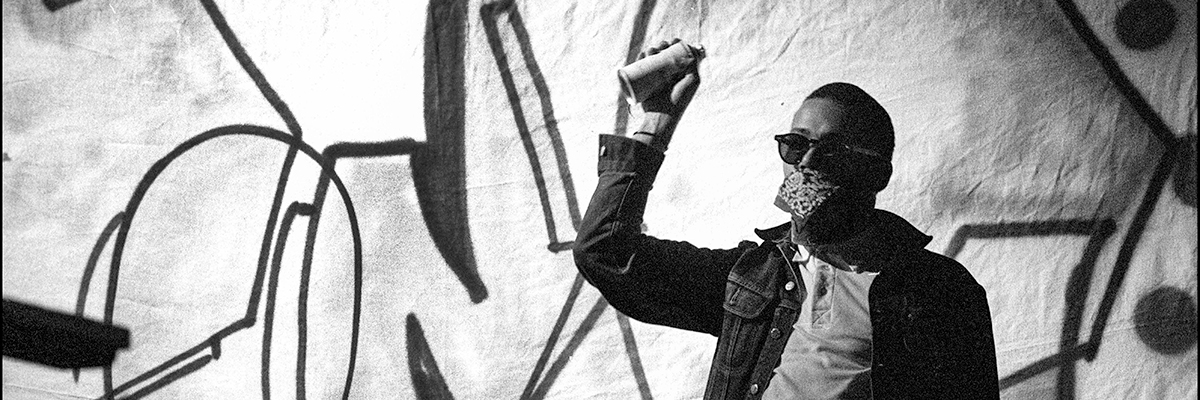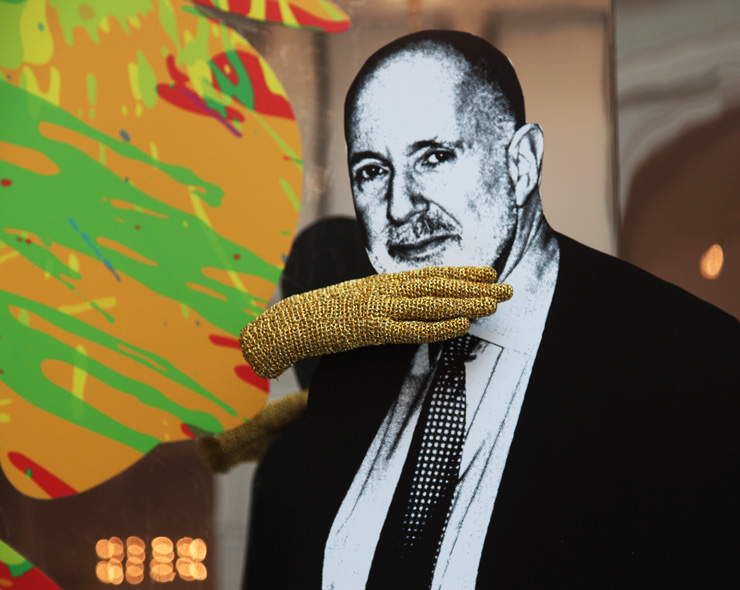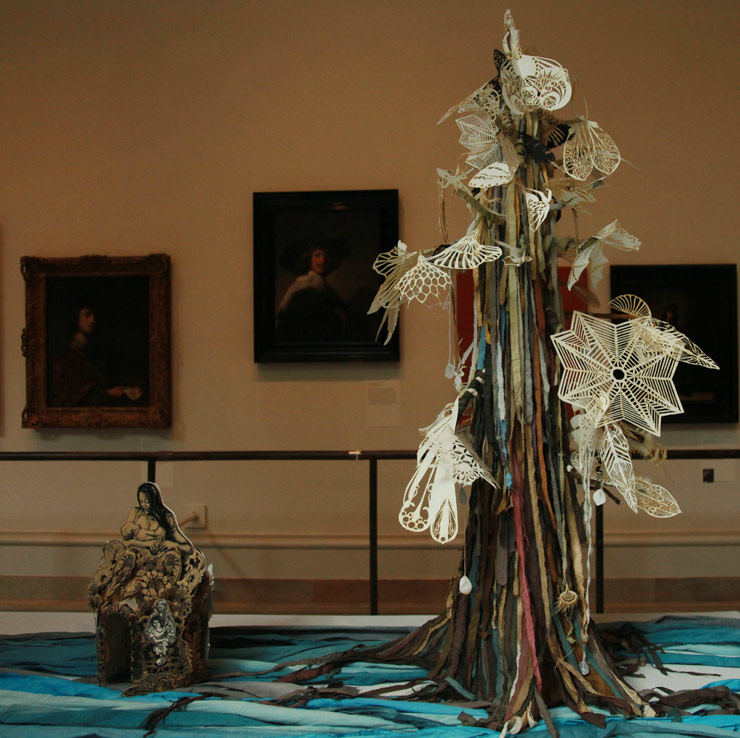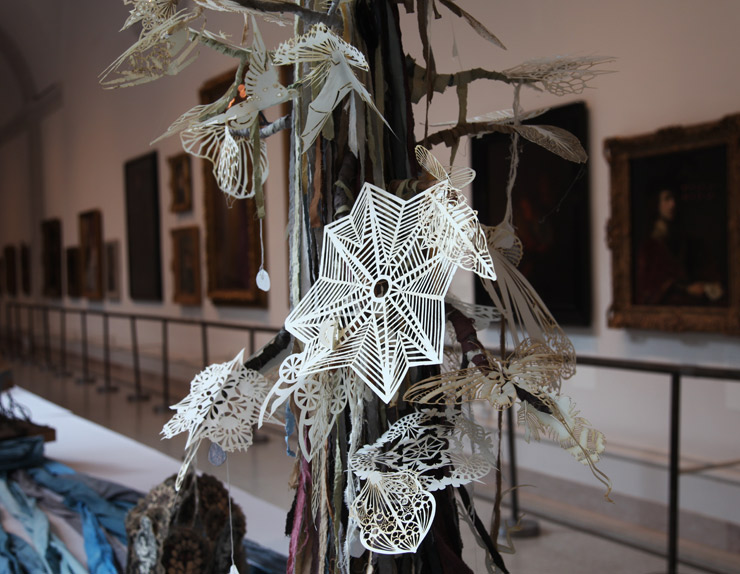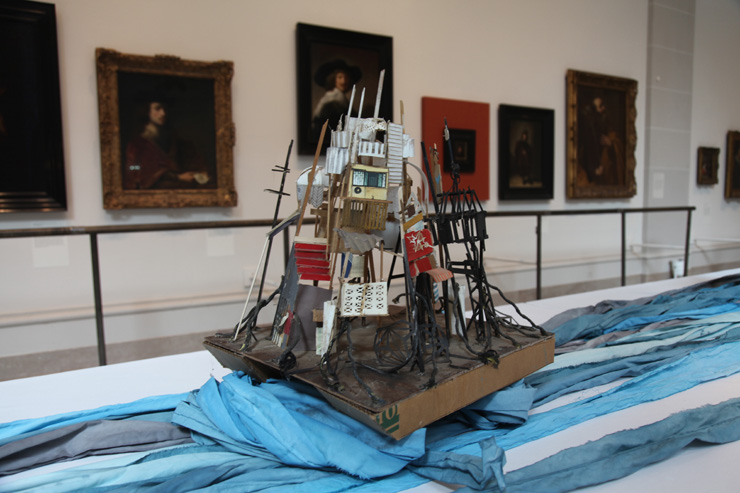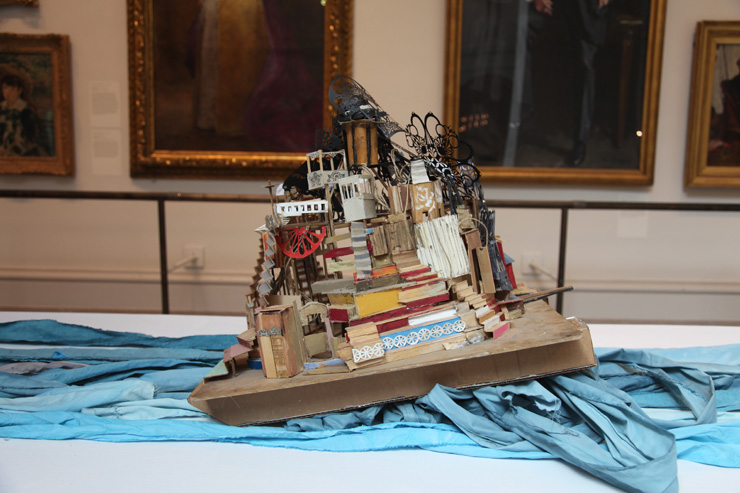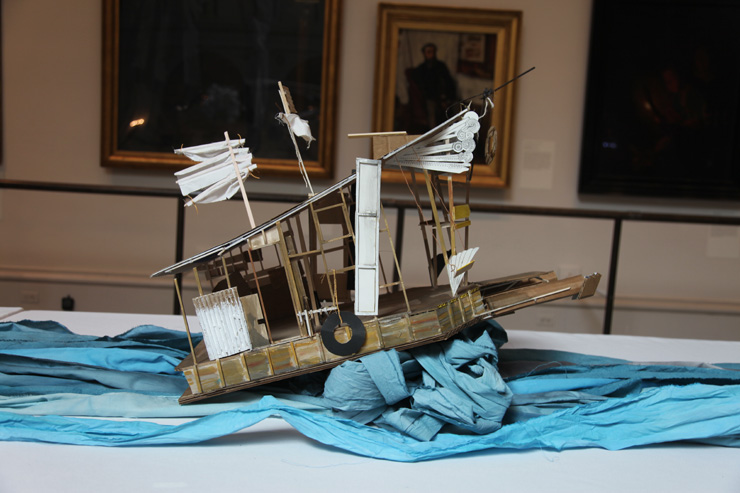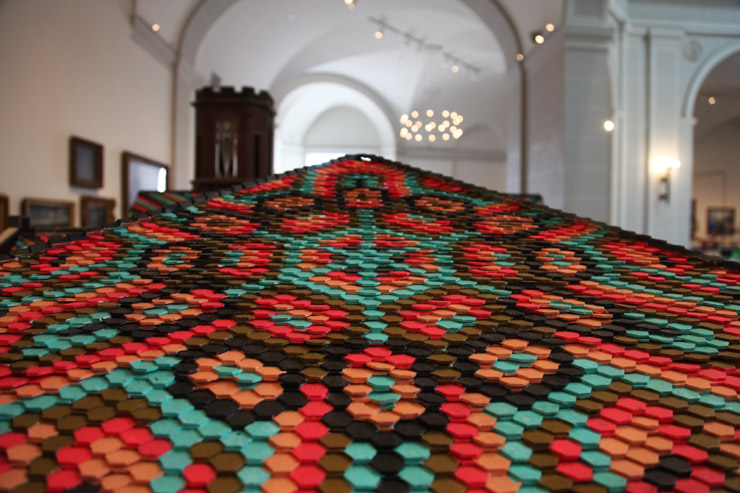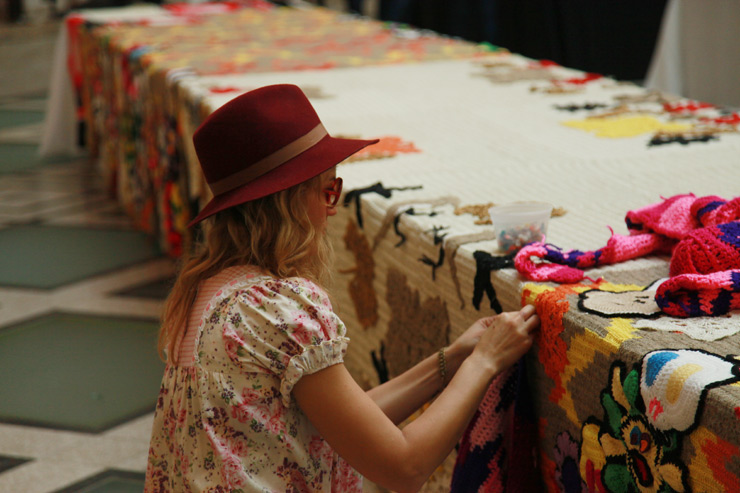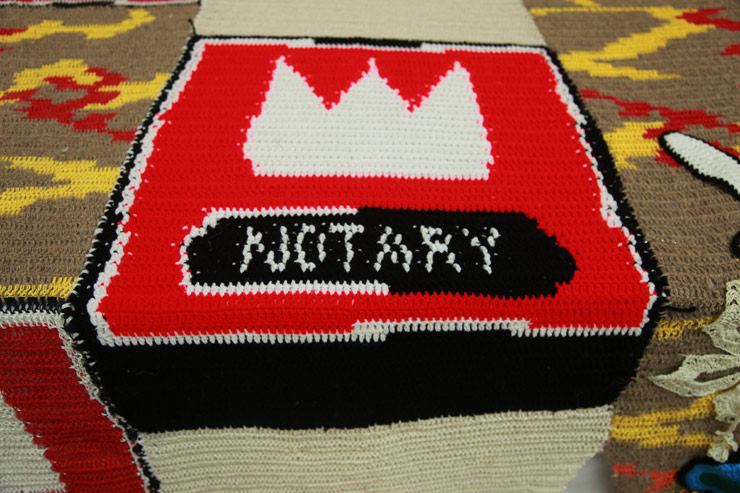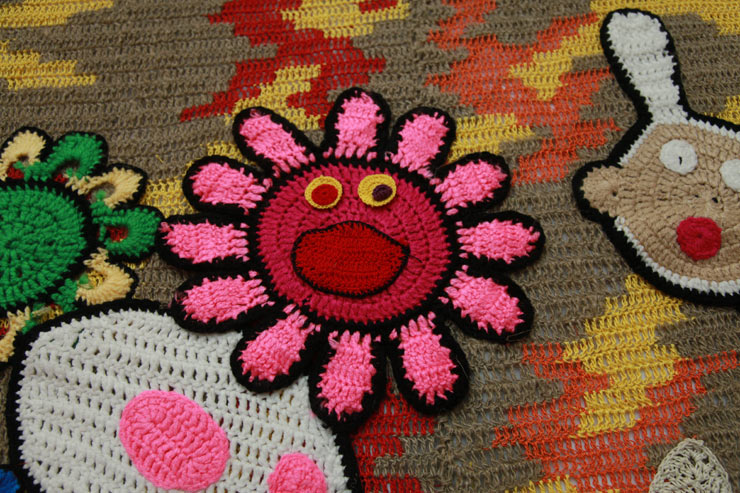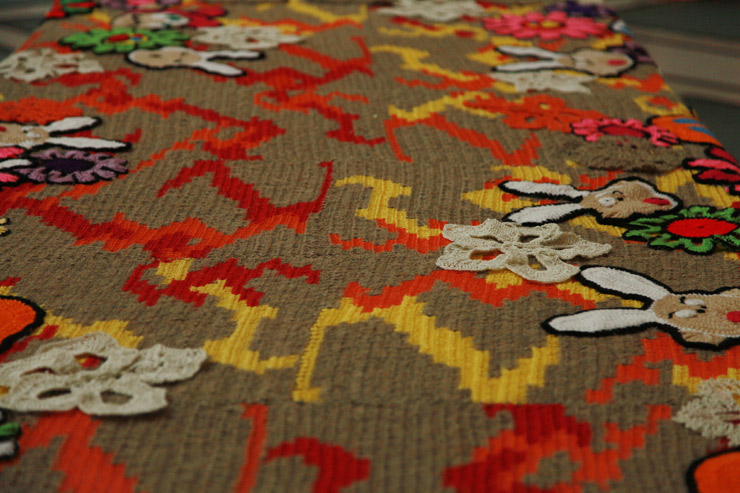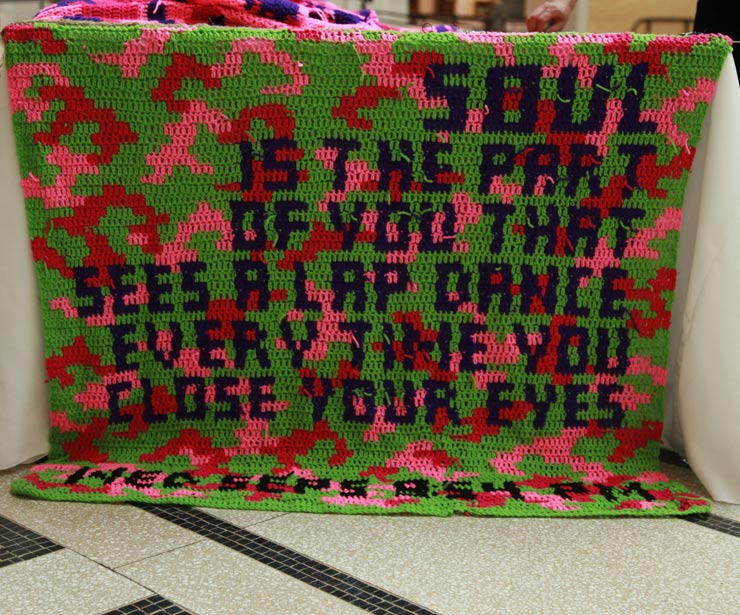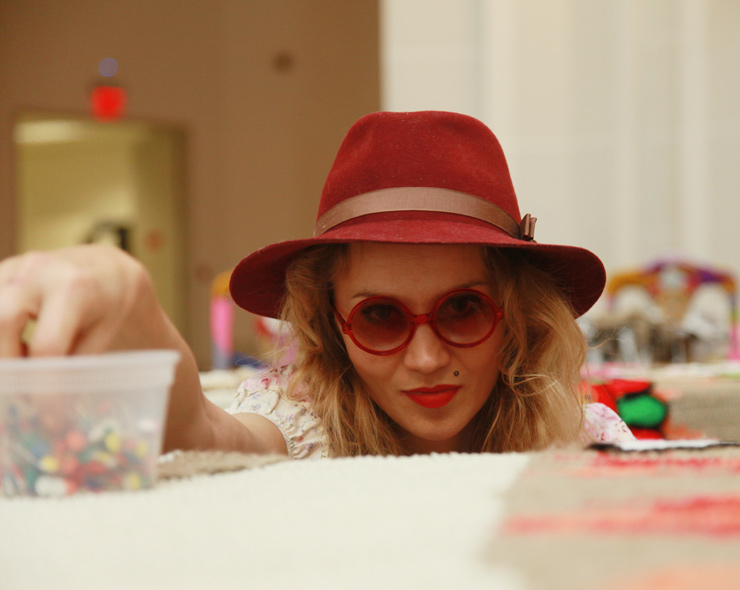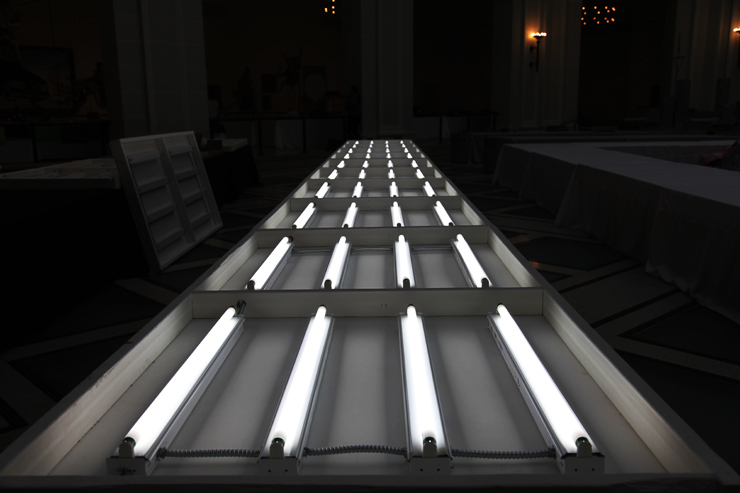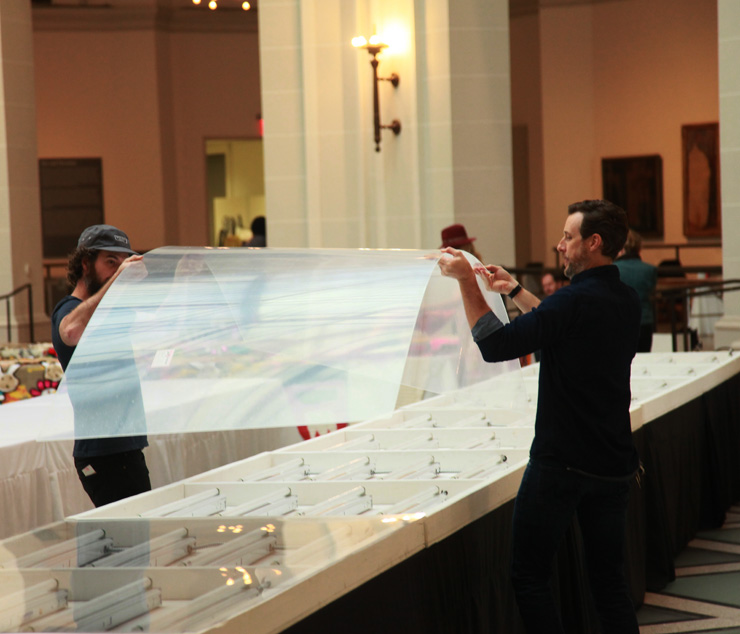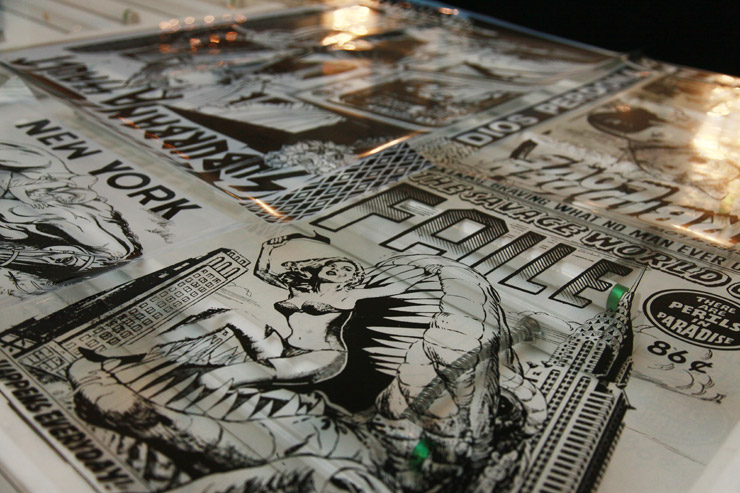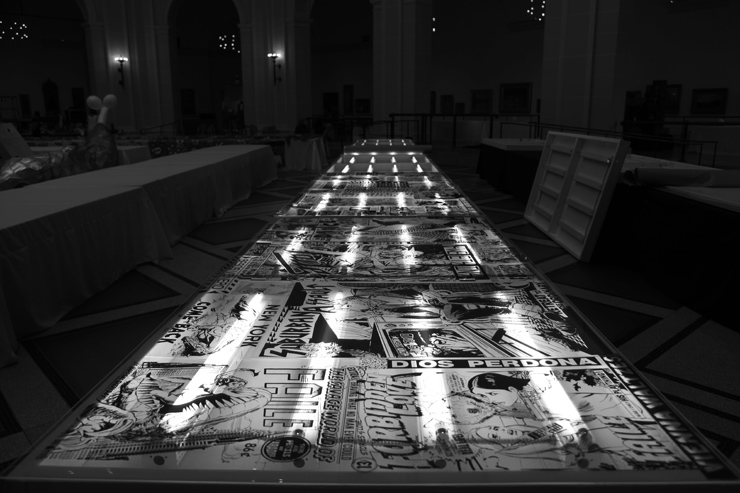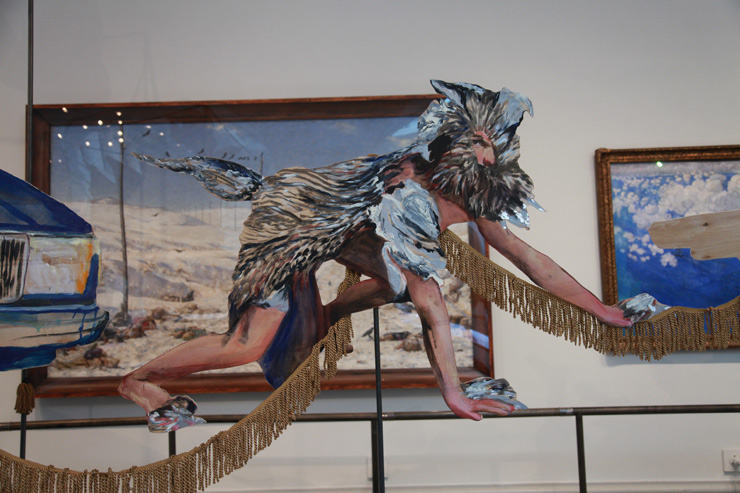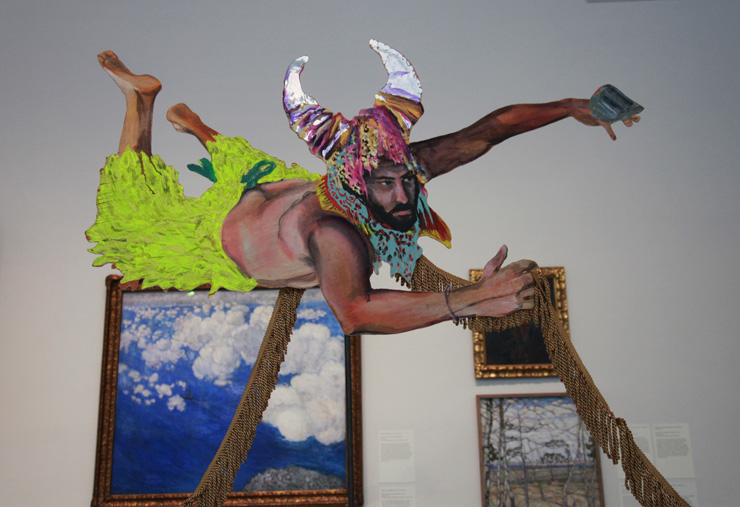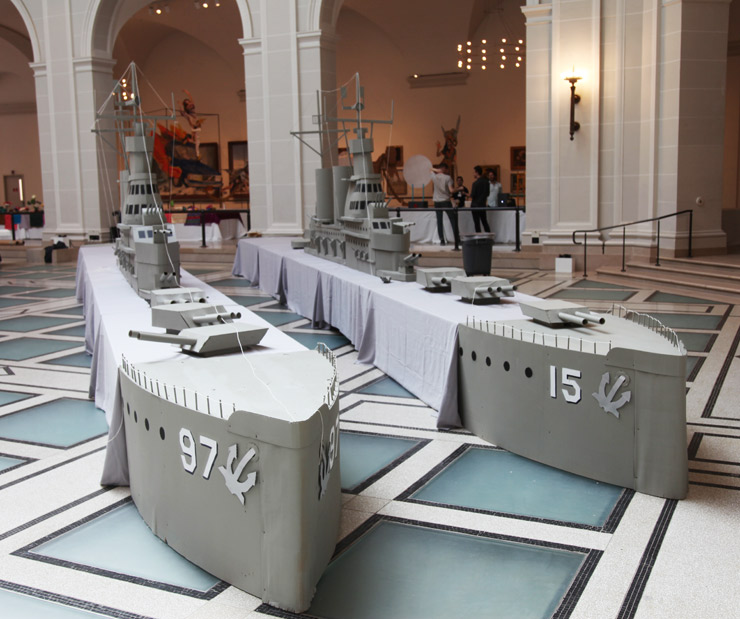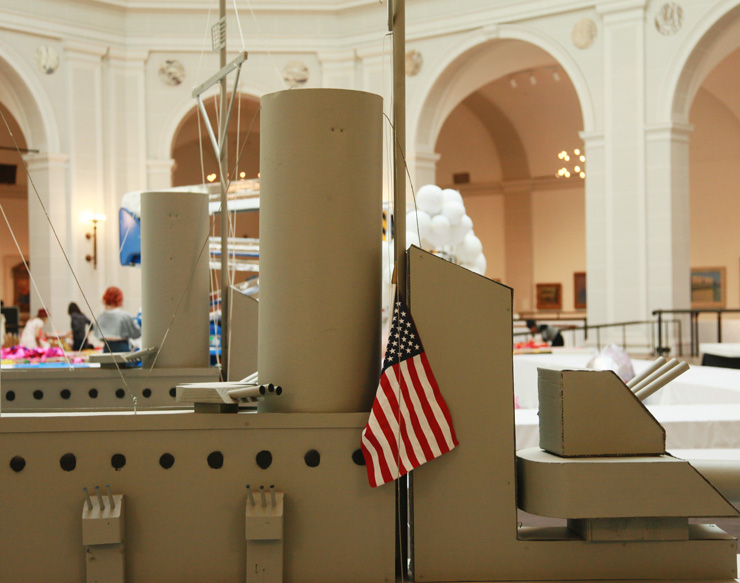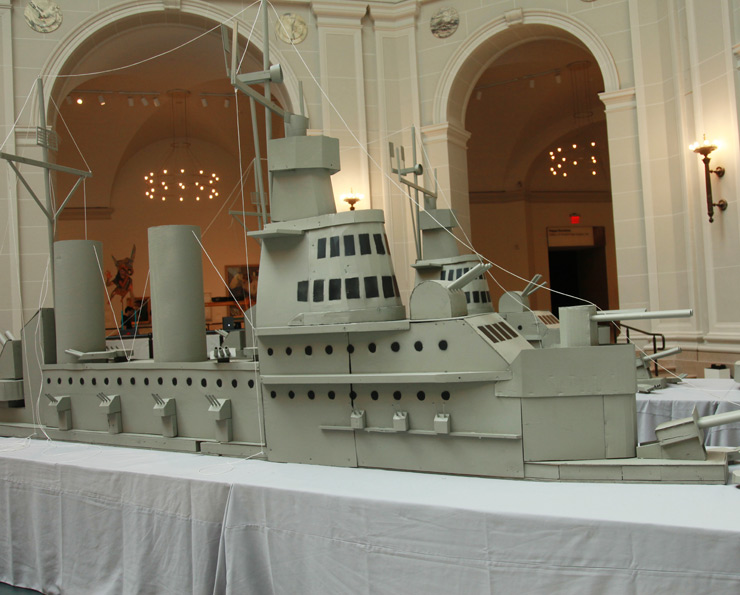FAILE may be a religious experience this summer at the Brooklyn Museum, but only one of the hallowed installations is called Temple. The seedier, more dimly lit venue will surely have the larger number of congregants by far, bless their sacred hearts.
Celebrating the duality and appropriation of words, slogans, and images has been the baliwick of the duo since they first began hitting Brooklyn streets at the turn of the century with their stencils and wheat-pastes on illegal spots and neglected spaces. In FAILE: Savage/Sacred Young Minds, their new attention commanding/refracting exhibit organized by Sharon Matt Atkins at the Brooklyn Museum, these guys pour it on, compelling you into a complex panoply of possible re-imaginings of meaning that reference pop, pulp, myth, art history, 50s sci-fi, 60s advertising, comics, punk zines, consumer culture and their own pure artistic and branded fiction.
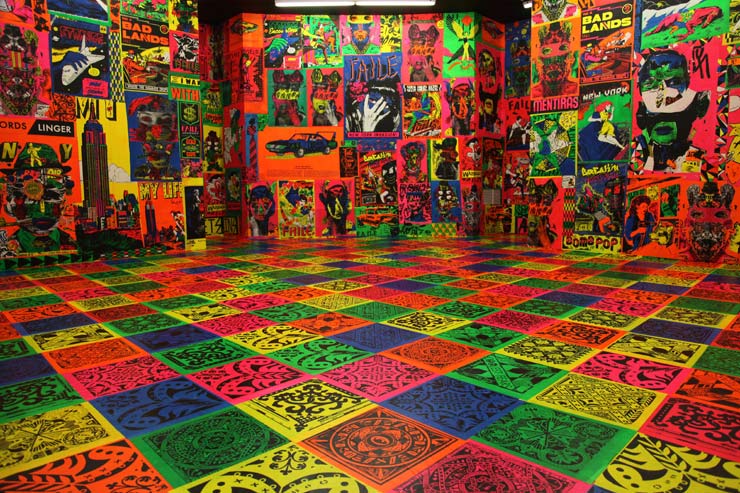
FAILE. The FAILE & BÄST Deluxx Fluxx Arcade. “Faile: Savage/Sacred Young Minds” Brooklyn Museum, July 2015. (photo © Jaime Rojo)
For fans of this collaboration between artists Patrick McNeil and Patrick Miller, Savage/Sacred is a joyride swerving through the visual vocabulary and terminology they’ve been emblazoning across walls, doorways, canvasses, stickers, sculptures, prayer wheels, wood blocks, paintings, prints, toys, and a museum façade in their steady ascendance from anonymous art school students and Street Artists to a highly collected top tier name in contemporary art.
Offering you a full immersion and opportunity for titillating interaction, this show provides an unambiguous sense of the industry that is backing the Faile fantasy. Throughout their work and your imagination and assumed role, you may be villain, distressed damsel, wolfman, fairey, vandal, wrestler, hot-rodder, madonna, whore, supplicant, avenger, surfing horse or simply an arcade hero who is whiling away windowless hours punching buttons, popping flippers and pumping Faile tokens into tantalizing art machines.
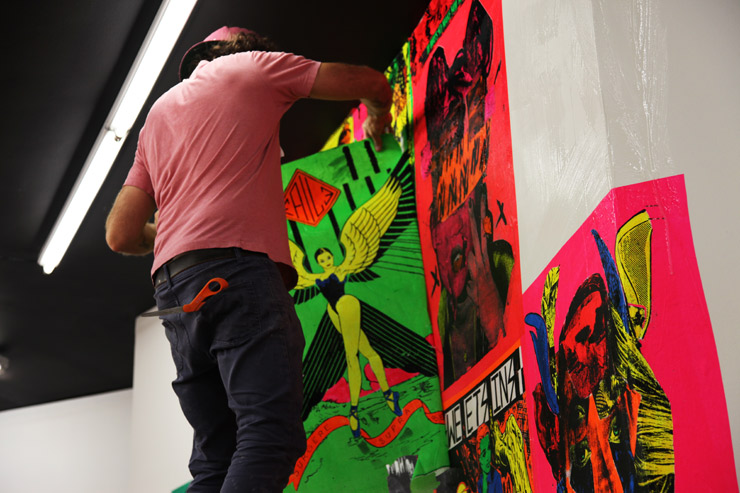
FAILE. FAILE & BÄST Deluxx Fluxx Arcade. “Faile: Savage/Sacred Young Minds” Brooklyn Museum, July 2015. (photo © Jaime Rojo)
Central to the formative Faile story is an image of the teenage Patricks piecing together clues about the world in these dark dens of possibility and teenage angst, awash in fantasy, aggression, testosterone and communal alienation.
Miller talks about the arcade atmosphere with a certain reverence, “All through Middle School, especially on the weekends, you’d just get dropped off at the mall and be there all day. There is something about the idea of this being a somewhat sacred space as a teenager in arcades. They are sort of a “Candyland” – a magical space mixed with a little seediness. You had kind of a large age range in there. You could get in trouble if you wanted but through the video games you could live out these crazy fantasy experiences. Historically arcades have been like that – very much with the Times Square notion. They’ve always had that connection to an underbelly of things.”
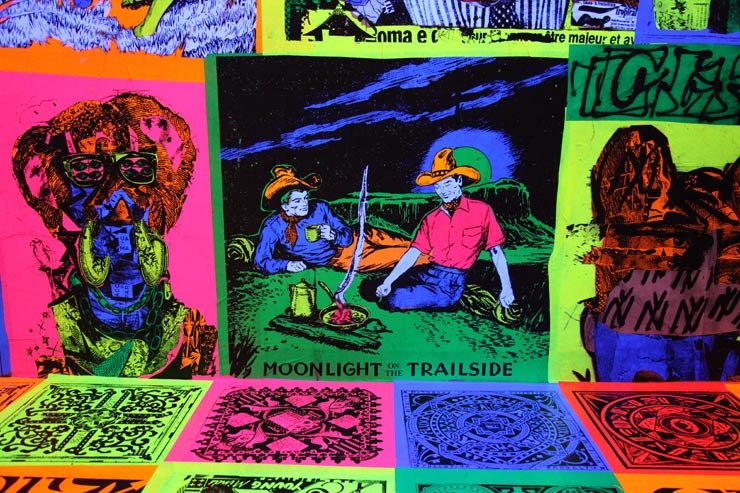
FAILE. The FAILE & BÄST Deluxx Fluxx Arcade. “Faile: Savage/Sacred Young Minds” Brooklyn Museum, July 2015. (photo © Jaime Rojo)
BSA: Do you think New York is still seedy?
Patrick Miller: It seems like it is getting harder to find, in a way.
BSA: So really you might say that this is a public service, this installation.
Patrick Miller: There are so many young people who have never had this experience today. Not only are we trying to share what that was like, it is something that shaped the way we are inspired as artists and the way we make imagery, the way we make icons. The roots of video-game culture are there and now that has sort of bled out today – but also we’re interested in the shared experience because so much of the video game experience is now mobile or is just had on your couch, I think people have forgotten that there used to be these places were you congregated to do this.
For the 5th public offering of FAILE BÄST Deluxx Fluxx Arcade and the first in a museum setting, Faile extends the scope and adds a handful of new NYC-centric scenarios to the mix and again partners with fellow Brooklyn street artist and spin-cycle collage mutator-in-chief BÄST, whose stylistic counterplay alerts undercurrents of tension with a punk-naïve primal hand painting and humoristic Dada collaging.
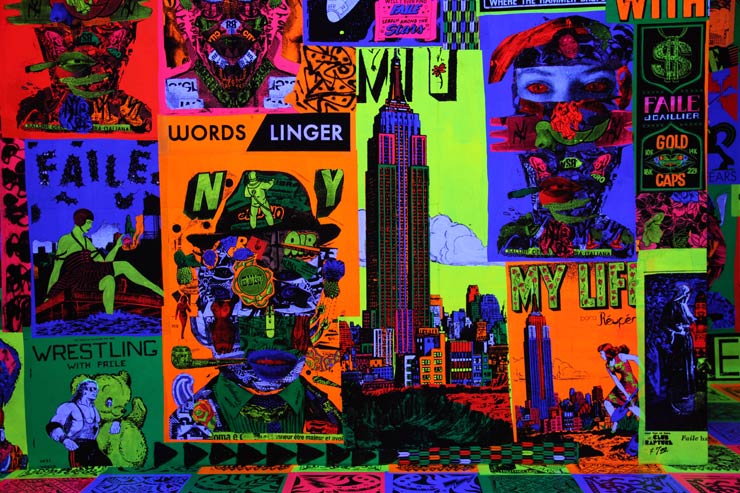
FAILE. The FAILE & BÄST Deluxx Fluxx Arcade. “Faile: Savage/Sacred Young Minds” Brooklyn Museum, July 2015. (photo © Jaime Rojo)
BSA: Can you describe the working dynamic with Faile and BÄST?
Patrick Miller: We’ve always been really inspired by BÄSTs work because we start from a similar place but we end up totally differently.
BSA: Yeah the end result is very different
Patrick Miller: Ours are probably more structured and narrative.
Patrick McNeil: I think over time we have tried not to step on each others’ toes. He generally controls the half-tone territory and we control the line-drawing territory.
BSA: So his are more photography-based and yours tend more toward the illustration.
Patrick McNeil: Yep
Patrick Miller: I think the work comes from the same place but his is just turned up to “11”.
Patrick McNeil: Yeah his is more put into a blender.
Patrick Miller: But that has always been what makes us work well together, the styles mix and marry really well and they kind of bring the best out of both.
BSA: And he has become even more abstract recently – more lo-fi outsider artish…., although you guys have delved into children’s coloring books for inspiration as well
McNeil: I think BÄST would like to call it more “outsider art”.
BSA: Why has it been important to keep Deluxx Fluxx a Faile-BÄST collaboration over the last five years thoughout its various iterations?
McNeil: We started this project as a collaboration and we’ve been collaborating with BÄST for fifteen years. We’ve always enjoyed working with him because we just love the friendship and we love the product of our collaborations. I think having the opportunity to be at the Brooklyn Museum and to do it together with him is really special.
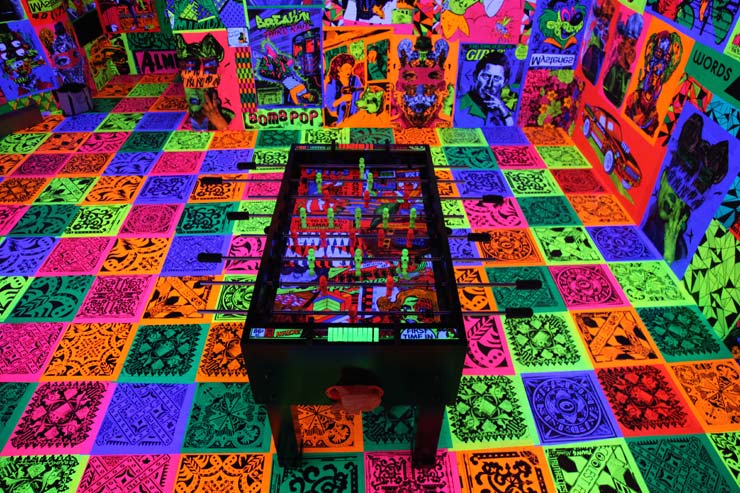
FAILE. The FAILE & BÄST Deluxx Fluxx Arcade. “Faile: Savage/Sacred Young Minds” Brooklyn Museum, July 2015. (photo © Jaime Rojo)
Twenty-two in all, the custom designed variations on arcade video and pinball games from the 1970s and 80s alert competitive urges and quests for domination alongside more mundane tasks like alternate side of the street parking and completing atypical digital art-making sessions where “winning” is defined entirely differently.
Social, sexual, comical, criminal, and environmental concerns all pop and parry while you nearly mindlessly and repetitively punch buttons and fire guns at herky-jerky 2-D motion graphics that transport you to the hi-charged arcade experience rumbling in malls and sketchier parts of town before the Internet. Get a taste for those darkened caves where you racked up points while quarters were sucked from your pockets; you are the favored hero at home in this seductive lair, surrounded by an ear pounding audio-musical triumphalist barrage of hypnotic hormonal victory and id-shattering explosions.
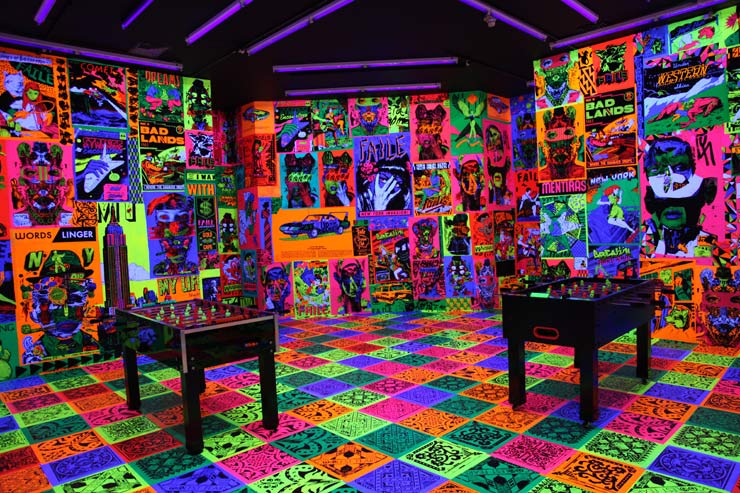
FAILE. The FAILE & BÄST Deluxx Fluxx Arcade. “Faile: Savage/Sacred Young Minds” Brooklyn Museum, July 2015. (photo © Jaime Rojo)
The adjoining cavernous black-light illuminated fluorescent foosball room is papered with mind-popping illustrations derived and sutured from comics, pulp and smarmy back-pages advertising that once stirred secret desires. Walking in on this teen temple you may feel like looking for dirty magazines sandwiched between mattresses; surely a hyped up juvenile would choose these alternating graphic “floor tiles” in radiation yellow, sugar coated pink and neon orange, giving your footsteps a spongey depth perception test on your way to a round of table football.
The floor-to-ceiling hand painted posters took four people six months to complete, both Patricks tell us, and they all compete for your attention, each a narrative re-configured and augmenting secret storylines, myths, and plenty of white lies.
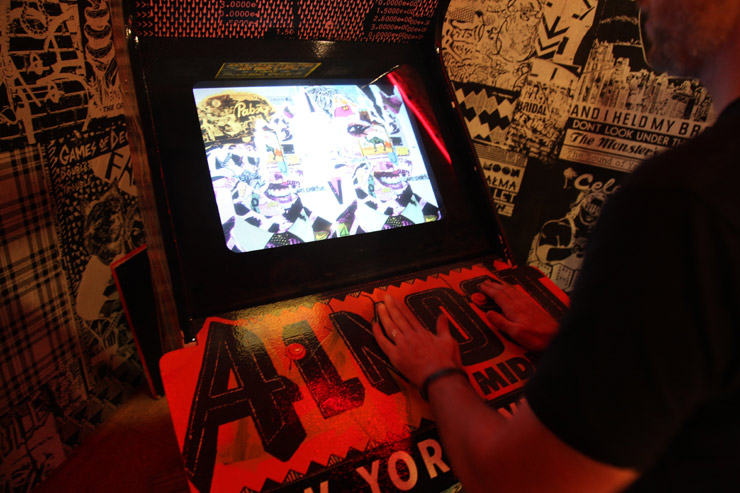
FAILE’s Patrick Miller demonstrates an art experience where you rip posters off the wall to reveal yet more Faile posters underneath, which you can rip further. FAILE. The FAILE & BÄST Deluxx Fluxx Arcade. “Faile: Savage/Sacred Young Minds” Brooklyn Museum, July 2015. (photo © Jaime Rojo)
Somehow it is here in the day-glo madness that we see the closest approximation to the original Street Art experience passersby had in the early 2000s with Faile’s work when they were still a trio that included artist AIKO and in those years just after her departure. These are the bold, familiar graphic punches thrown in a direction you weren’t expecting and can make you laugh.
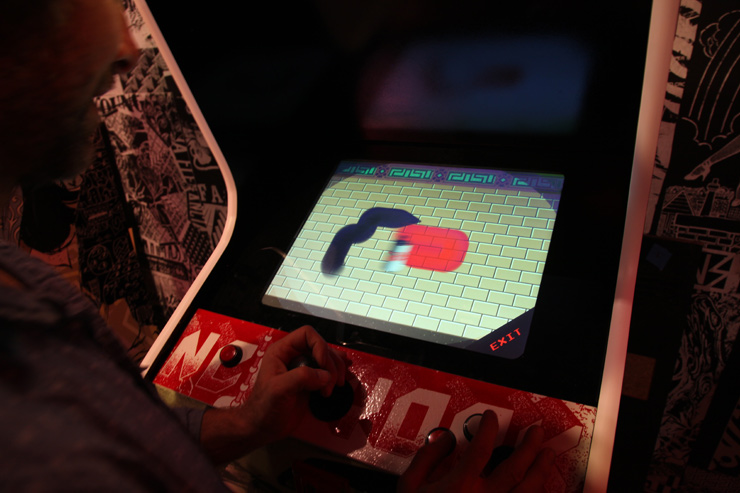
FAILE’s Patrick McNeil demonstrates how to tag subway walls before the “Bast Ghosts” come after you. FAILE. The FAILE & BÄST Deluxx Fluxx Arcade. “Faile: Savage/Sacred Young Minds” Brooklyn Museum, July 2015. (photo © Jaime Rojo)
In a media- and advertising-saturated society our tools of discernment and reason are compromised, deliberately so. Faile is recognizing some symptoms of this compromise and is examining the stories and the narratives that are told, crafting their own dramatic nomenclature from the pile. You might say that their stories are melding with an idealized simplification of North American white dude history, a heroic paranoid absolutism that lays bare the prejudices behind it.
A simple survey of words illustrates the perspective: prayer, bitch, horse, rainbow, sinful, Jesus, warriors, forbidden, Indian, hero, poison, brave, strong, boy, guilty, pleasure, bedtime, cowboys, hotrods, savage, gun, trust, stiletto, tender, hotel, confessions, fight, wolf, saved, girls, lies, vanity, inexperience, restless virgin, innocent, willing, heartbreak, torment, stories.
These are Faile stories, reconfigured with a slicing knife down the middle of the belly, an idiosyncratic collaged pop/pulp style that owes as much to the Dadaist Hannah Höch and pop collage originator Richard Hamilton as it does to Lichtenstein’s sense of storybook romance and Warhol’s repetitive emotional distance.
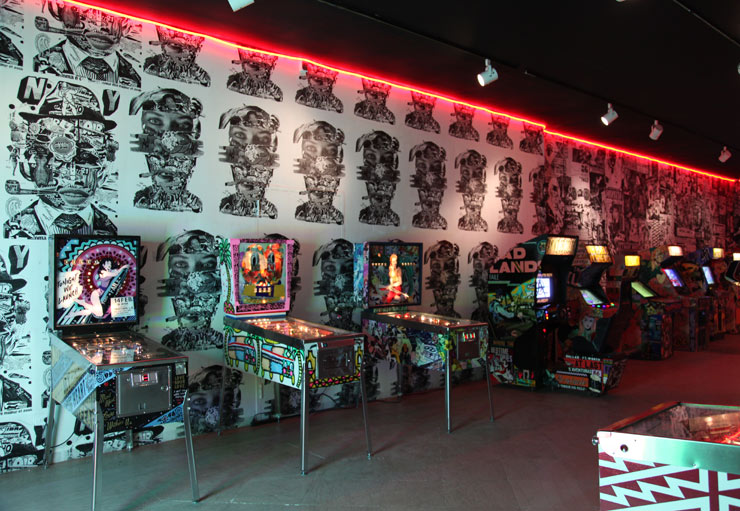
FAILE. The FAILE & BÄST Deluxx Fluxx Arcade. “Faile: Savage/Sacred Young Minds” Brooklyn Museum, July 2015. (photo © Jaime Rojo)
In the book accompanying the exhibit, Sharon Matt Atkins, Vice Director for Exhibitions and Collections Management, who organized the exhibition, says the presentation of the arcade in a museum setting “highlights how the present work relates to the art of the past and expands our expectations of the use of public spaces dedicated to art.” Here, she says, “Deluxx Fluxx’s arcade machines, which are simultaneously sculptures and functioning games, may call to mind Surrealism, Dada, and Fluxus, as well as the enigmatic boxed assemblages of Joseph Cornell.”
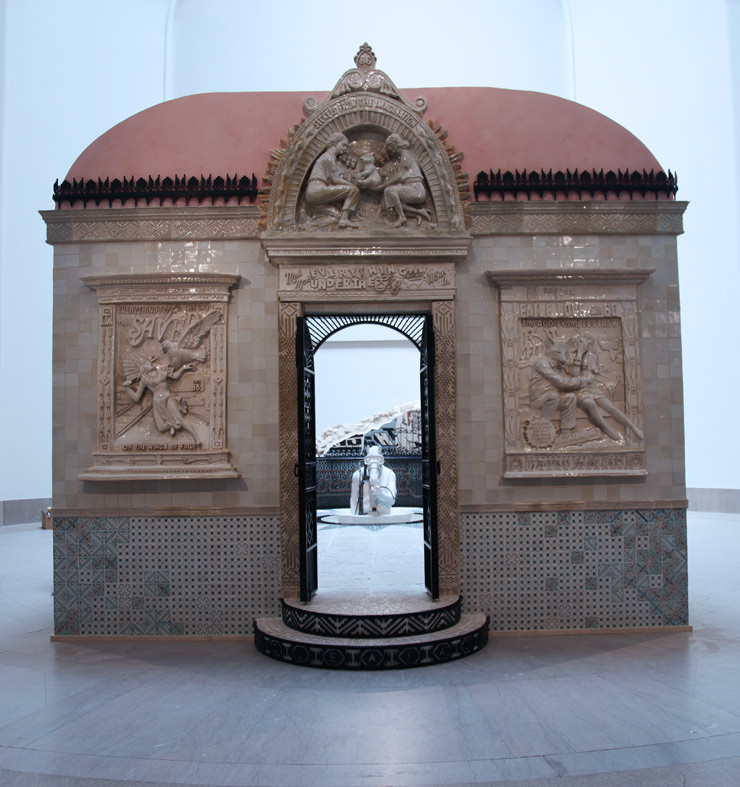
FAILE. Temple. “Faile: Savage/Sacred Young Minds” Brooklyn Museum, July 2015. (photo © Jaime Rojo)
Similarly, the signature Temple project has not been presented in its entirety in museum settings previously, and it feels like it is a bit of inspired genius when you are standing in its shadow beneath the soaring sky light at the Brooklyn Museum. The full scale church in ruins was presented out of doors in Praça dos Restauradores Square in Lisbon in conjunction with Portugal Arte in 2010. Echoing its surroundings in Lisbon, the Temple here is also a willful remix of the epic and the rather lesser so.
Culture-jamming at its height, it’s a punk subversion in ceramic, marble and iron that simultaneously genuflects and gives the finger to antiquity and to our soulless consumer culture. By casting reliefs of stylized font-work, romance novelette themes, and ads for call girls in puzzling non-sequitors, the Temple ridicules vapidity while honoring connections to age-old themes, sort of humbling all involved. Here again Faile is questioning the received wisdom of art history, religious customs, and tales of great societies we’ve learned to be reverent of, or maybe just questioning our true knowledge of history altogether.
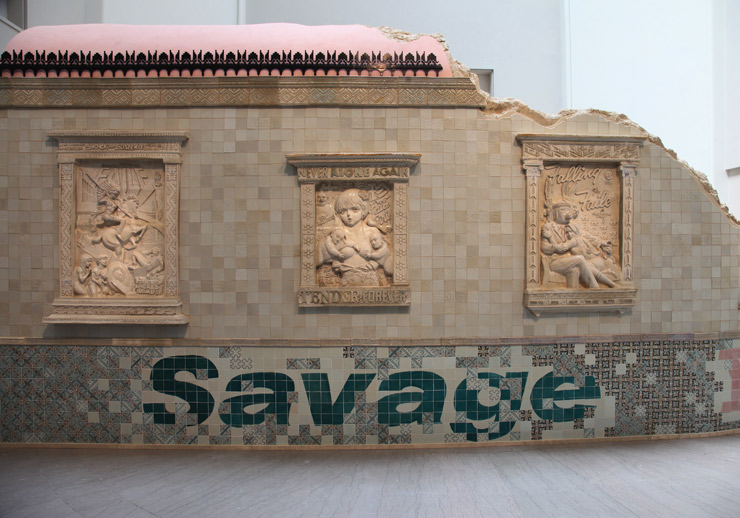
FAILE. Temple. “Faile: Savage/Sacred Young Minds” Brooklyn Museum, July 2015. (photo © Jaime Rojo)
During the last months while it was being unpacked and assembled we heard the Temple also called a tomb, a mausoleum, a chapel – the differences shared by their ties to the architecture and sculpture and tiled mosaics and ceramic under one roof. The roof in this case is destroyed – possibly because it caved in or because it was ripped off by an angry god who said, “You have missed my point entirely!”
In any case it is a formidable structure allowing meditation, reflection, confusion. In an act of ultimate bait and switch, Faile has deliberately played with what you are supposed to be paying attention to, substituting the associated original intended and inferred meanings of a religious institution and its power. You approach with reverence, looking perhaps for an allegorical means to access the transcendental, but expected symbols have been supplanted by the shallow relics of a culture you may have intended to escape.
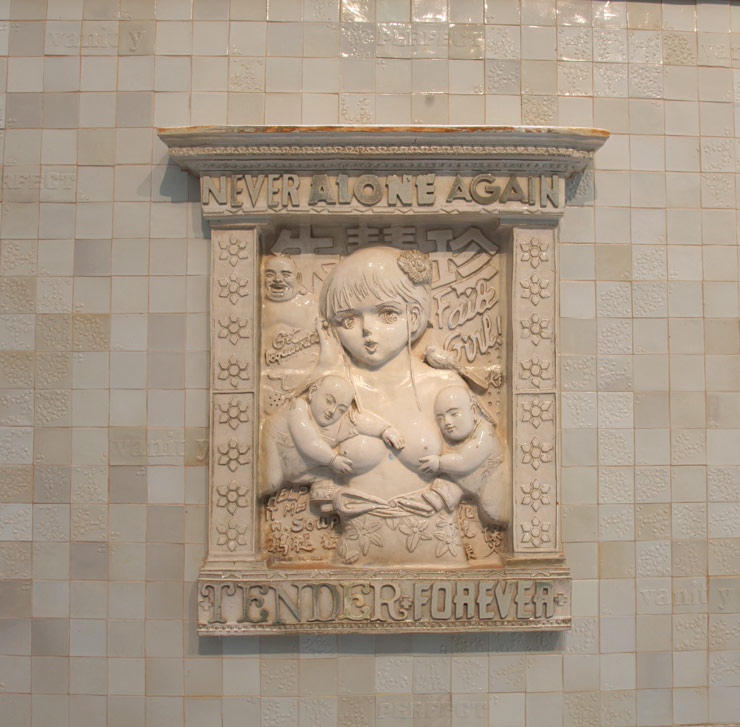
FAILE. Temple. “Faile: Savage/Sacred Young Minds” Brooklyn Museum, July 2015. (photo © Jaime Rojo)
Ultimately Faile is not unlike a lot of the world’s great religions; Comforting, reassuring, challenging, mysterious, inpenetrable. Sometimes you have the feeling that there are other people who understand it much better than you. Oh, ye of little Faile. Lean not upon your own understanding. Failes ways are not necessarily our ways. Whether these words and narratives are written by man or handed down from a higher power, why sweat it? It’s a holy good show.
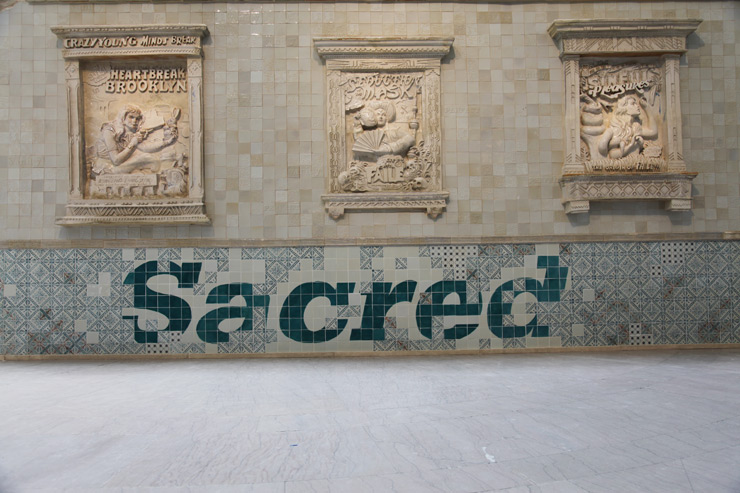
FAILE. Temple. “Faile: Savage/Sacred Young Minds” Brooklyn Museum, July 2015. (photo © Jaime Rojo)
With FAILE: Savage/Sacred Young Minds the Brooklyn museum is once again meaningfully invested in the present and jumped ahead in the examination of what clearly is the first global grassroots art movement, giving the stage to the current century’s voices of the street – perhaps because it has engaged with the city’s artists and communities.
With an enormous new Kaws sculpture in the lobby, Basquiat’s notebooks and Kehinde Wiley’s exhibition in the same year, Faile adds an important voice to the local/global narrative and to the dialogue about the appropriate role of art in the public sphere and major institutions in the cultural life of the community they a part of.
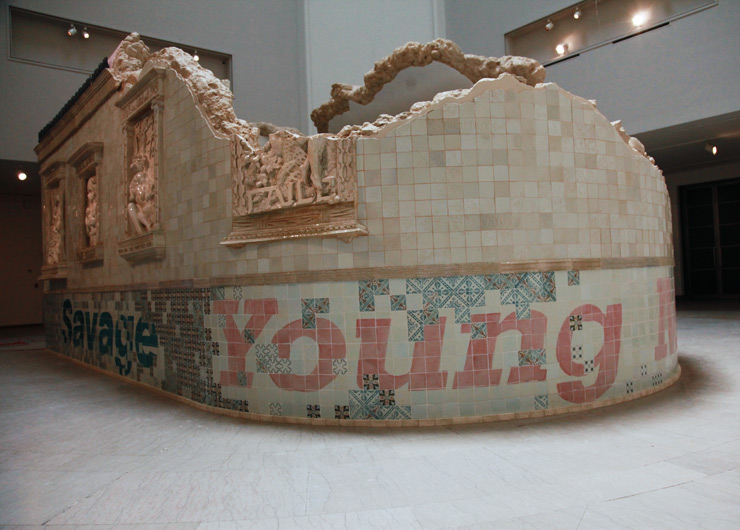
FAILE. Temple. “Faile: Savage/Sacred Young Minds” Brooklyn Museum, July 2015. (photo © Jaime Rojo)
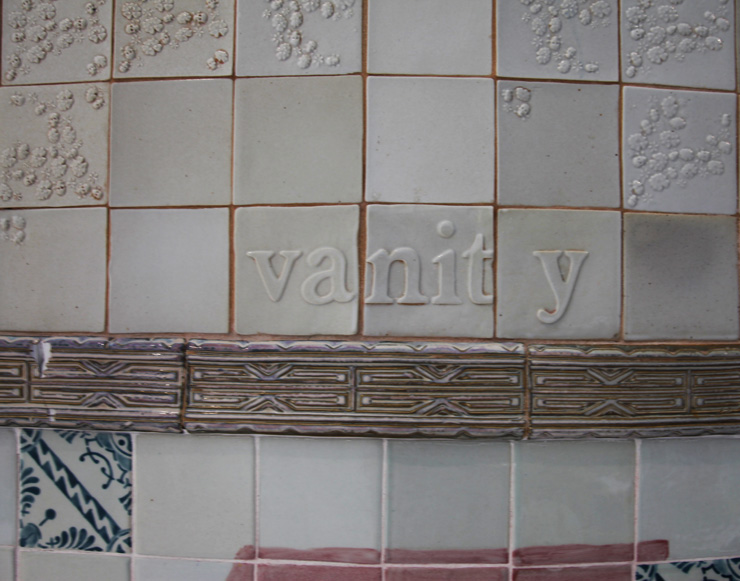
FAILE. Temple. “Faile: Savage/Sacred Young Minds” Brooklyn Museum, July 2015. (photo © Jaime Rojo)
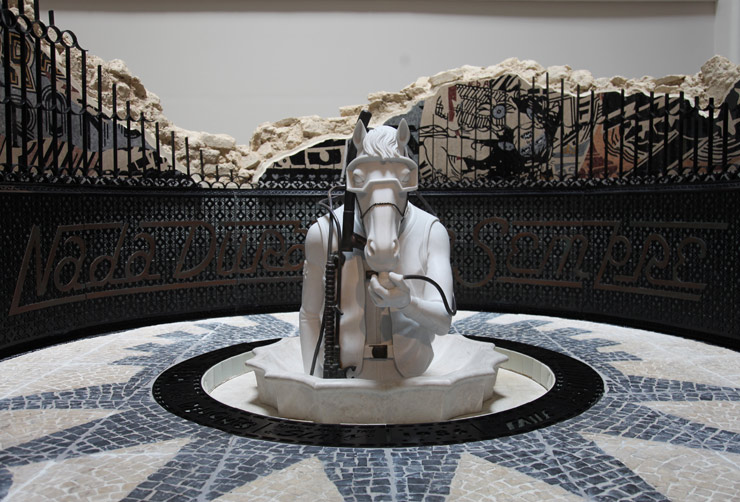
FAILE. Temple. “Faile: Savage/Sacred Young Minds” Brooklyn Museum, July 2015. (photo © Jaime Rojo)
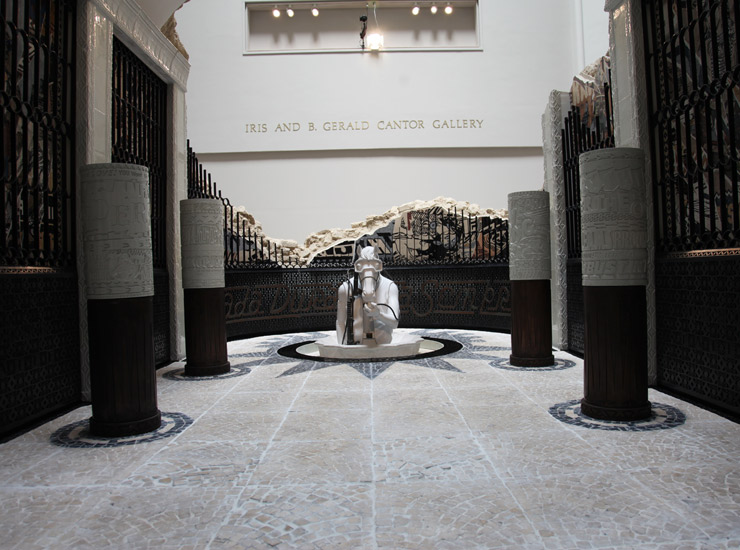
FAILE. Temple. “Faile: Savage/Sacred Young Minds” Brooklyn Museum, July 2015. (photo © Jaime Rojo)
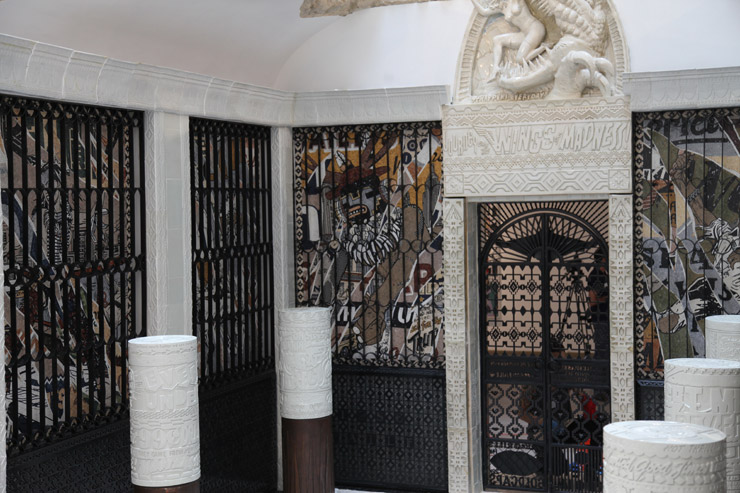
FAILE. Temple. “Faile: Savage/Sacred Young Minds” Brooklyn Museum, July 2015. (photo © Jaime Rojo)
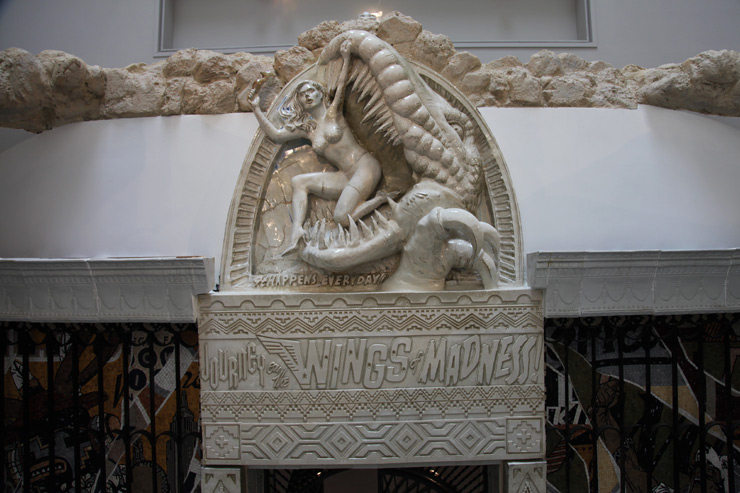
FAILE. Temple. “Faile: Savage/Sacred Young Minds” Brooklyn Museum, July 2015. (photo © Jaime Rojo)
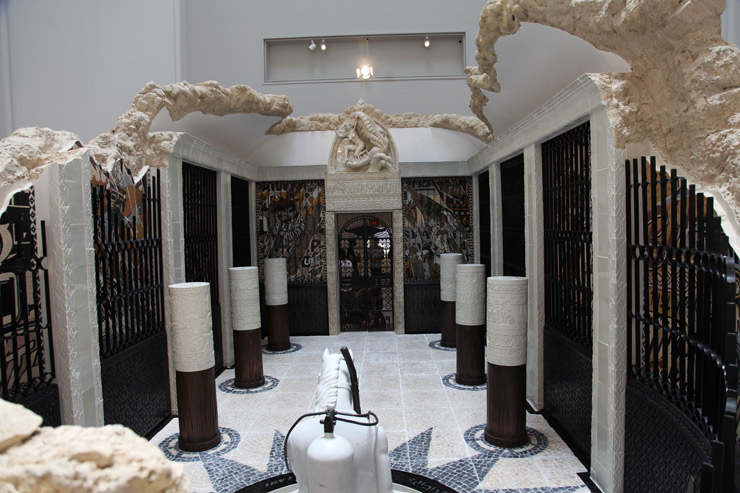
FAILE. Temple. “Faile: Savage/Sacred Young Minds” Brooklyn Museum, July 2015. (photo © Jaime Rojo)
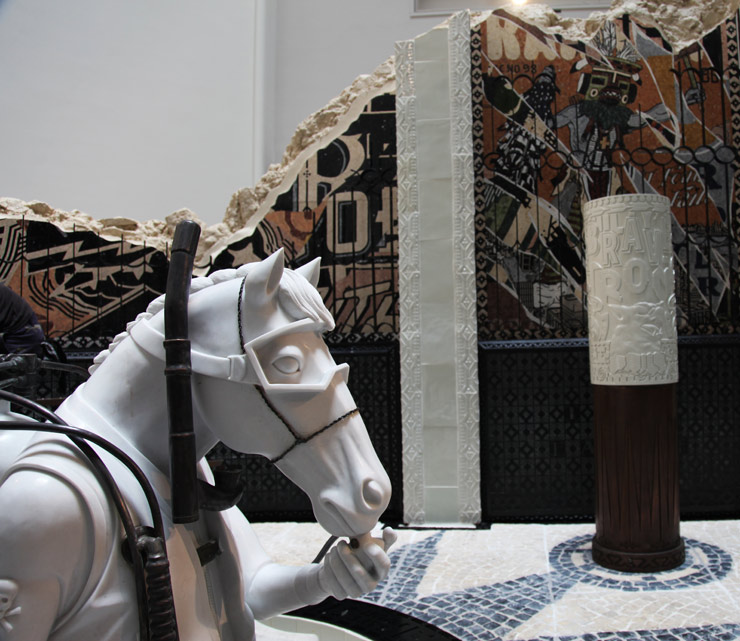
FAILE. Temple. “Faile: Savage/Sacred Young Minds” Brooklyn Museum, July 2015. (photo © Jaime Rojo)
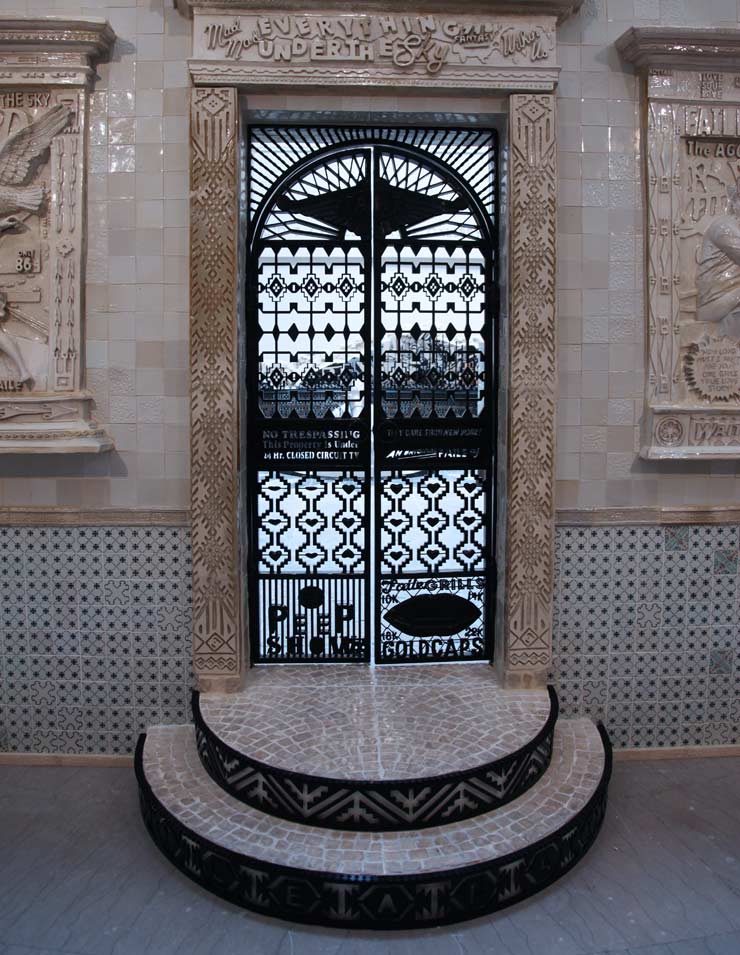
FAILE. Temple. “Faile: Savage/Sacred Young Minds” Brooklyn Museum, July 2015. (photo © Jaime Rojo)
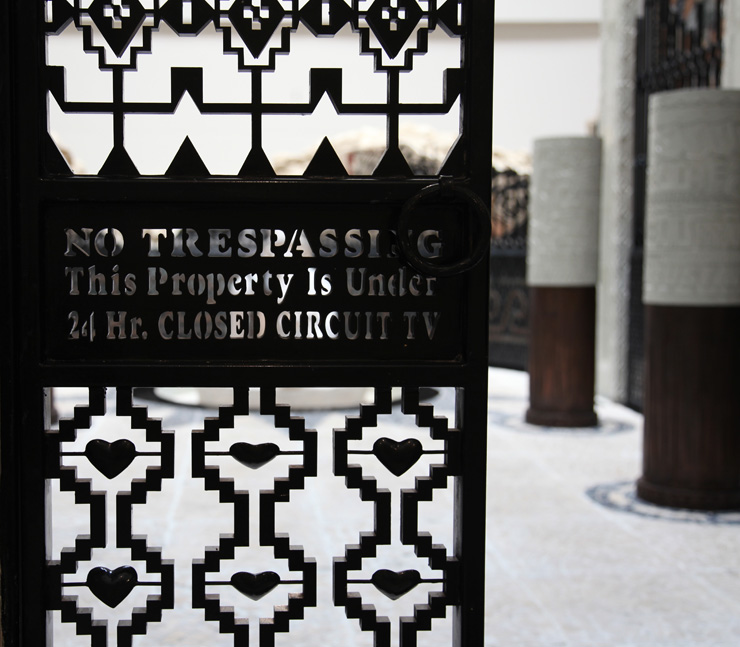
FAILE. Temple. “Faile: Savage/Sacred Young Minds” Brooklyn Museum, July 2015. (photo © Jaime Rojo)
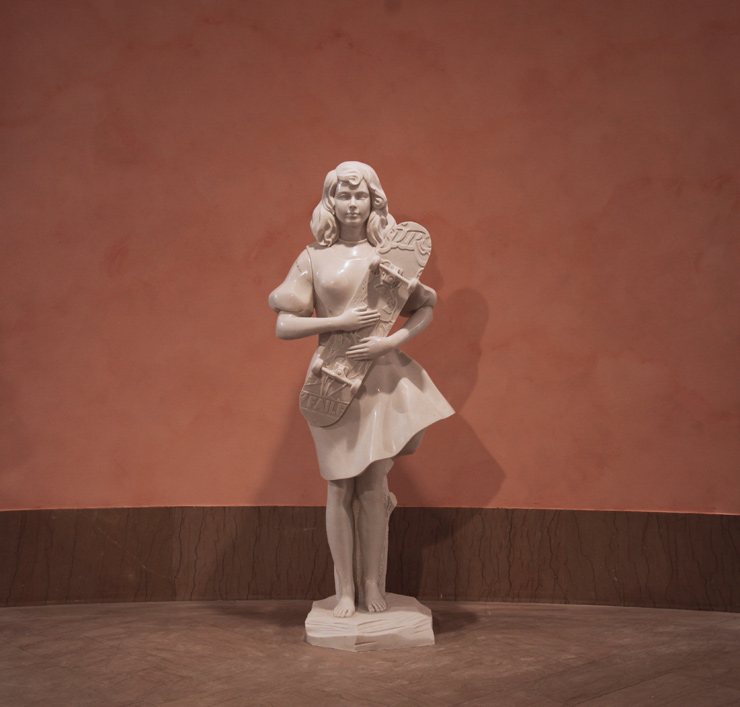
FAILE. Fantasy Island. “Faile: Savage/Sacred Young Minds” Brooklyn Museum, July 2015. (photo © Jaime Rojo)
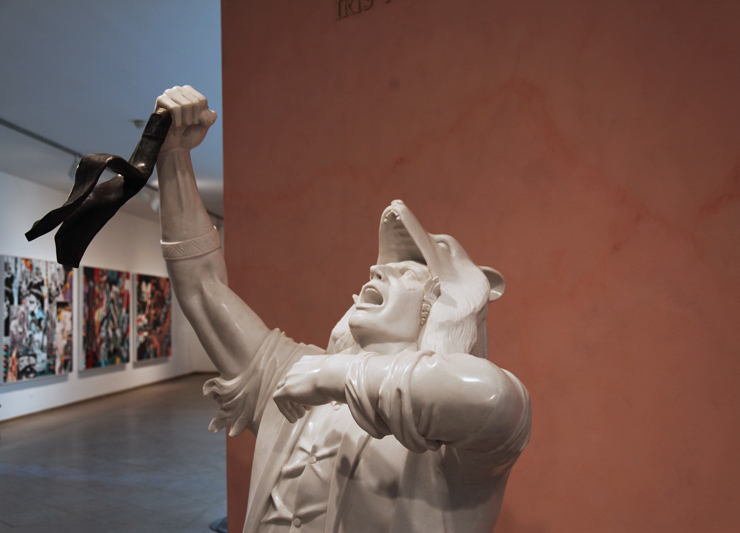
FAILE. Wolf Within. Detail. “Faile: Savage/Sacred Young Minds” Brooklyn Museum, July 2015. (photo © Jaime Rojo)
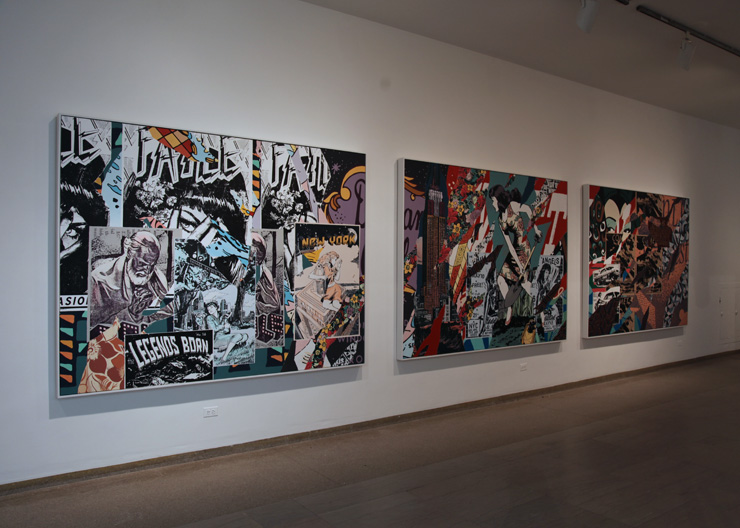
FAILE. Ripped canvases. “Faile: Savage/Sacred Young Minds” Brooklyn Museum, July 2015. (photo © Jaime Rojo)
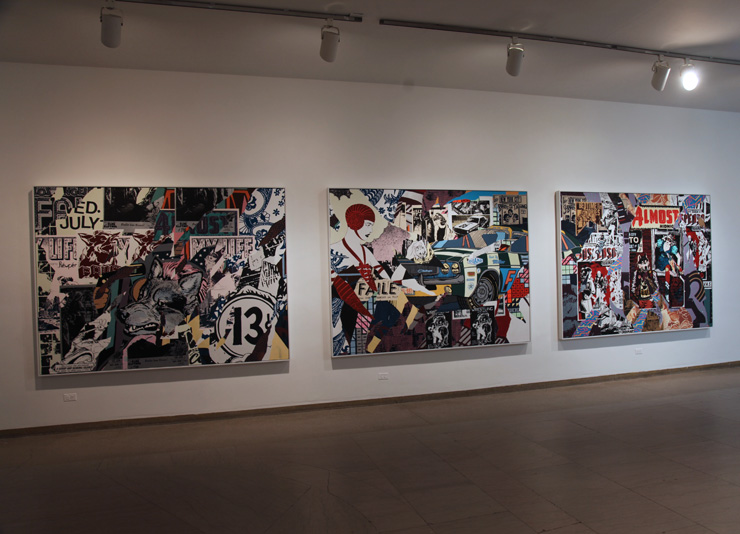
FAILE. Ripped canvases. “Faile: Savage/Sacred Young Minds” Brooklyn Museum, July 2015. (photo © Jaime Rojo)
“Faile: Savage/Sacred Young Minds” at the Brooklyn Museum will open Friday, July 10th. Click HERE for further information.
<<>>><><<>BSA<<>>><<<>><><BSA<<>>><><<>BSA<<>>><<<>><><BSA
Please note: All content including images and text are © BrooklynStreetArt.com, unless otherwise noted. We like sharing BSA content for non-commercial purposes as long as you credit the photographer(s) and BSA, include a link to the original article URL and do not remove the photographer’s name from the .jpg file. Otherwise, please refrain from re-posting. Thanks!
<<>>><><<>BSA<<>>><<<>><><BSA<<>>><><<>BSA<<>>><<<>><><BSA
This article is also published on The Huffington Post
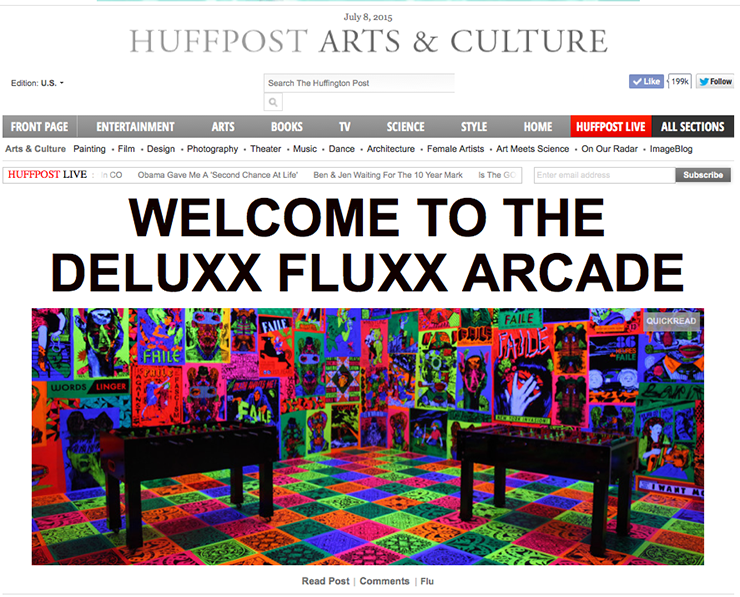
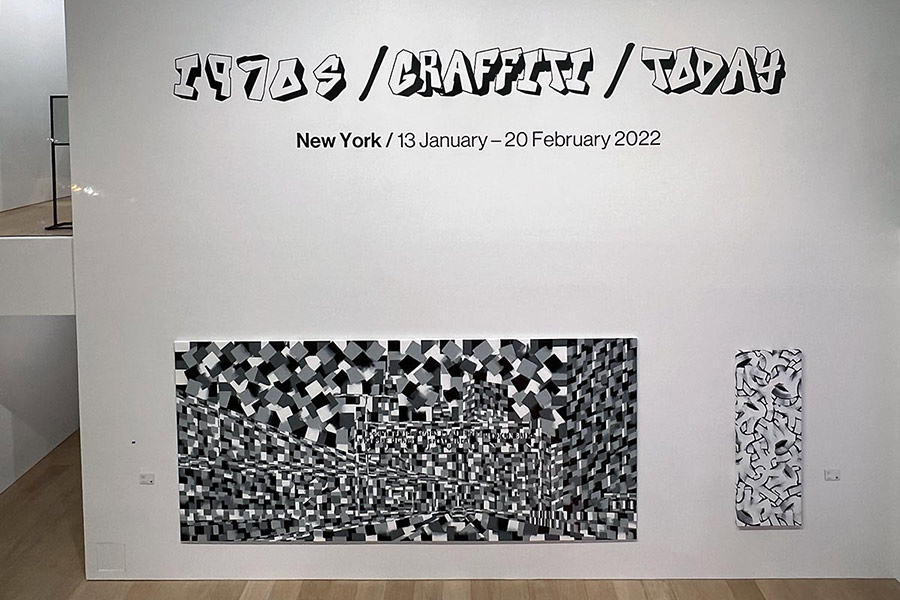
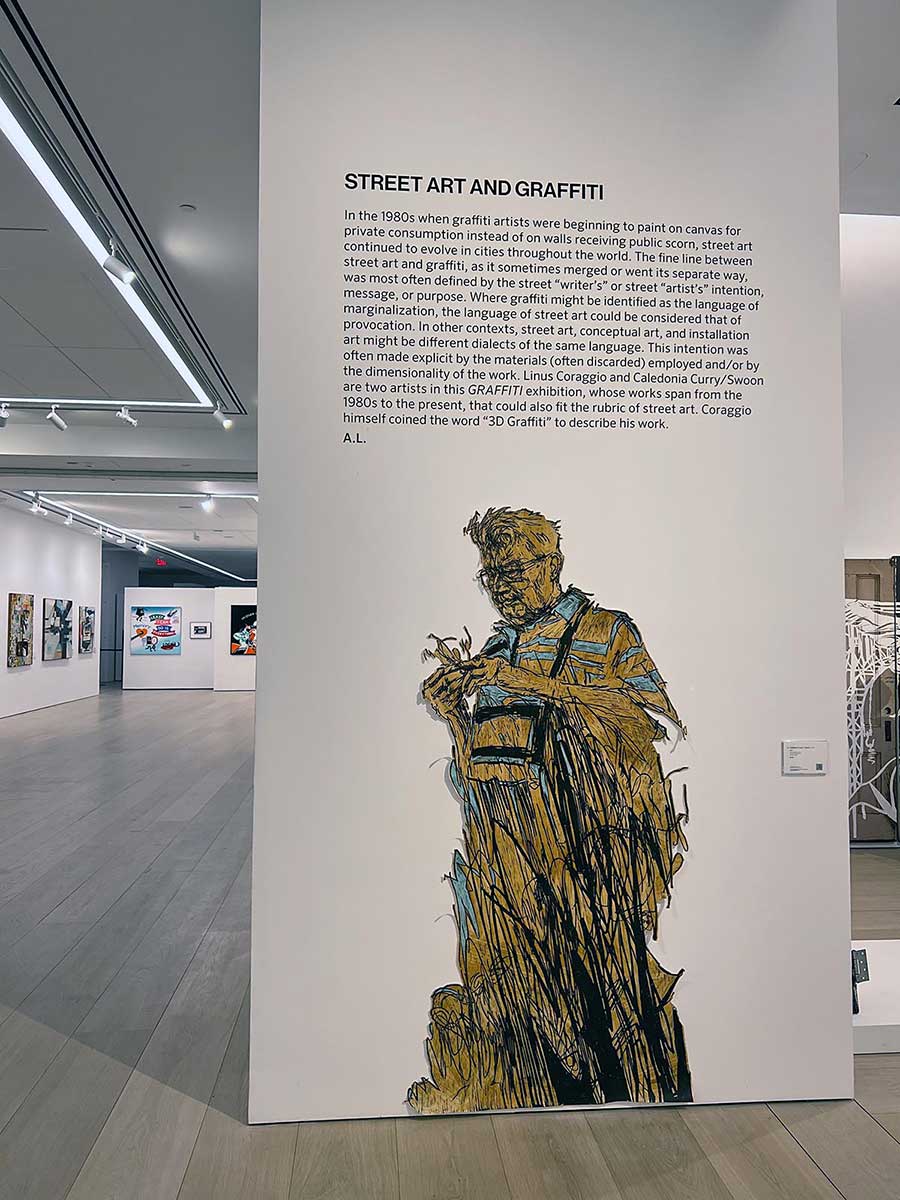
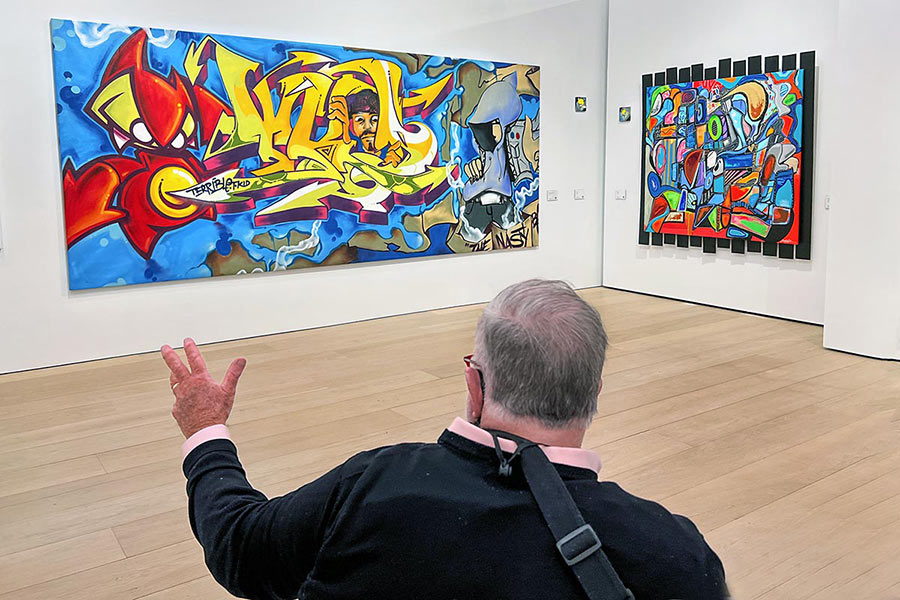
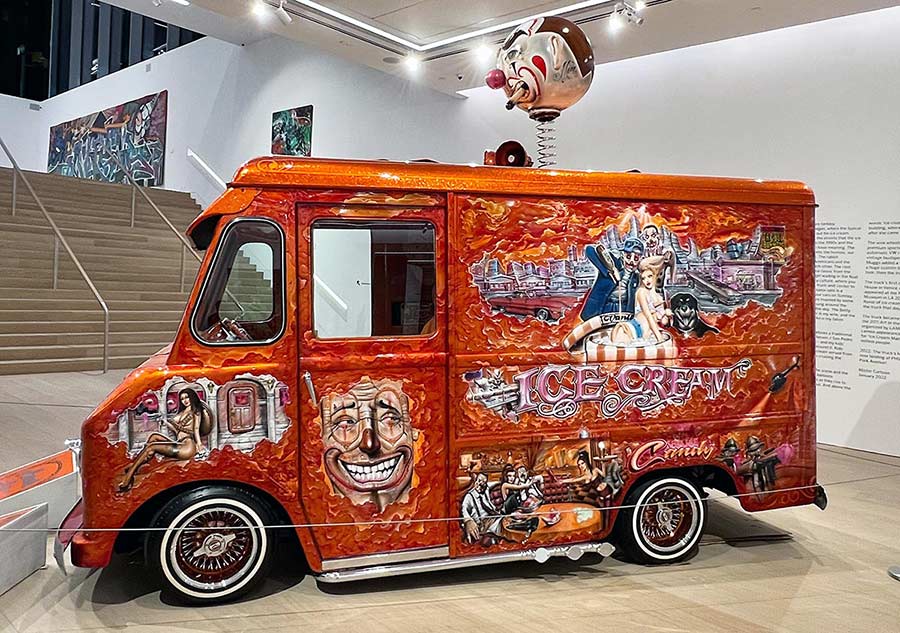
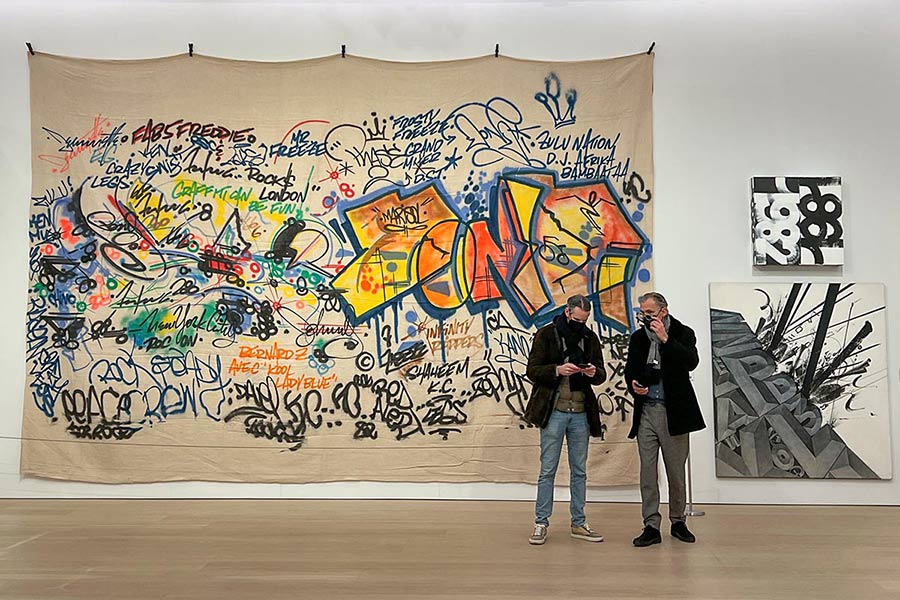
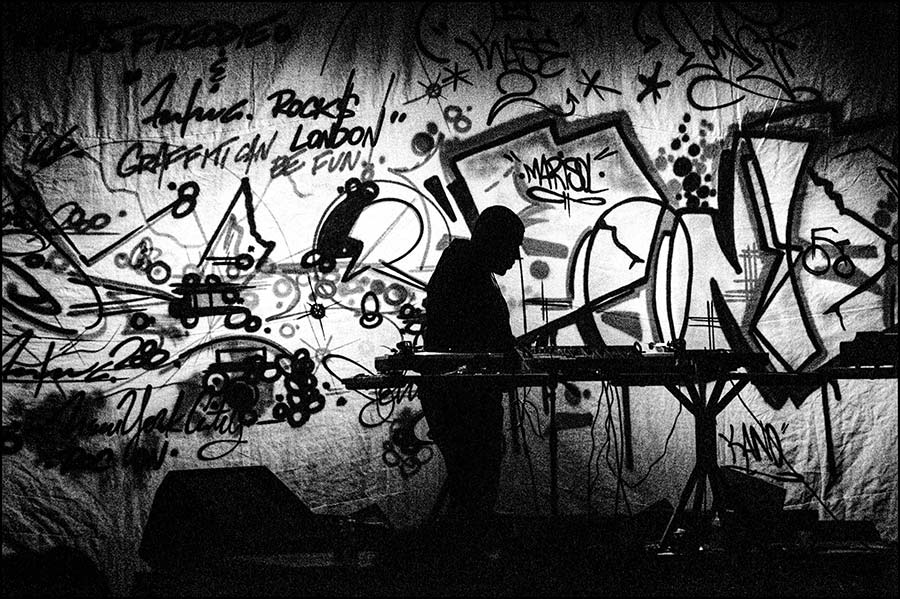
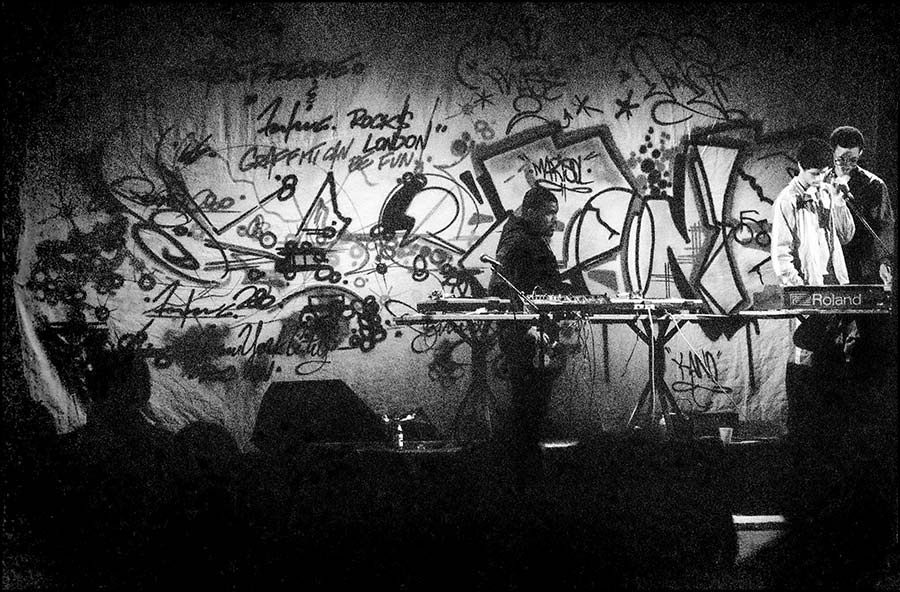
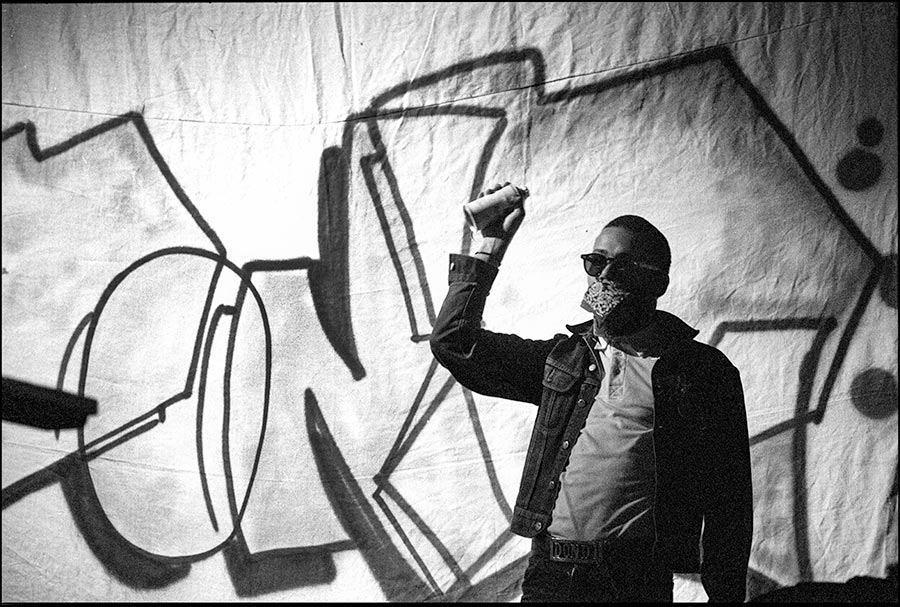
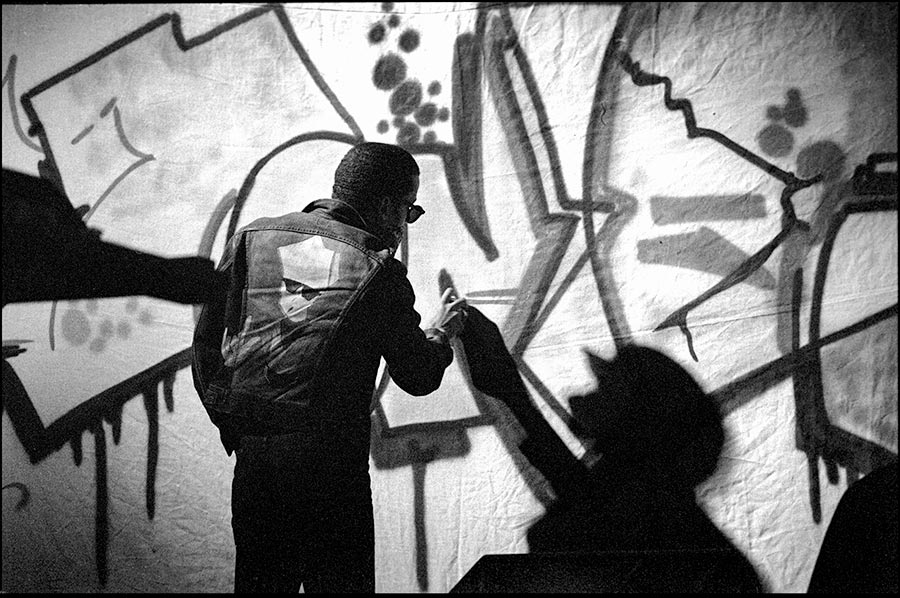
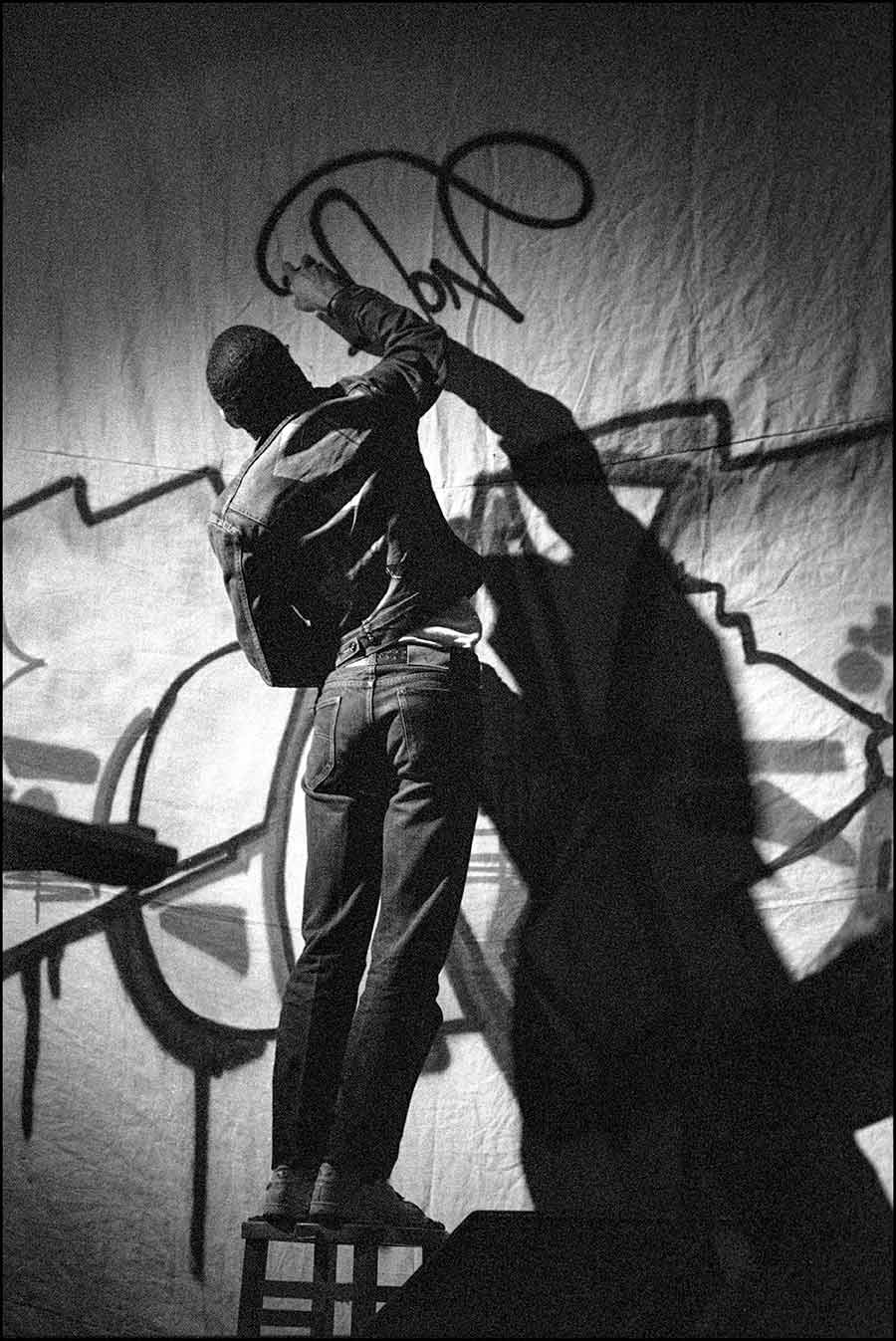
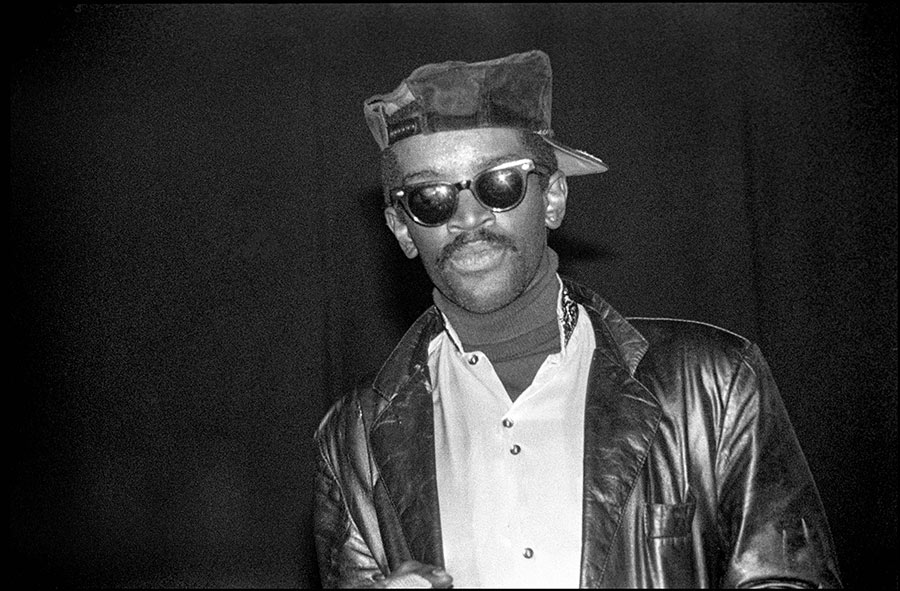
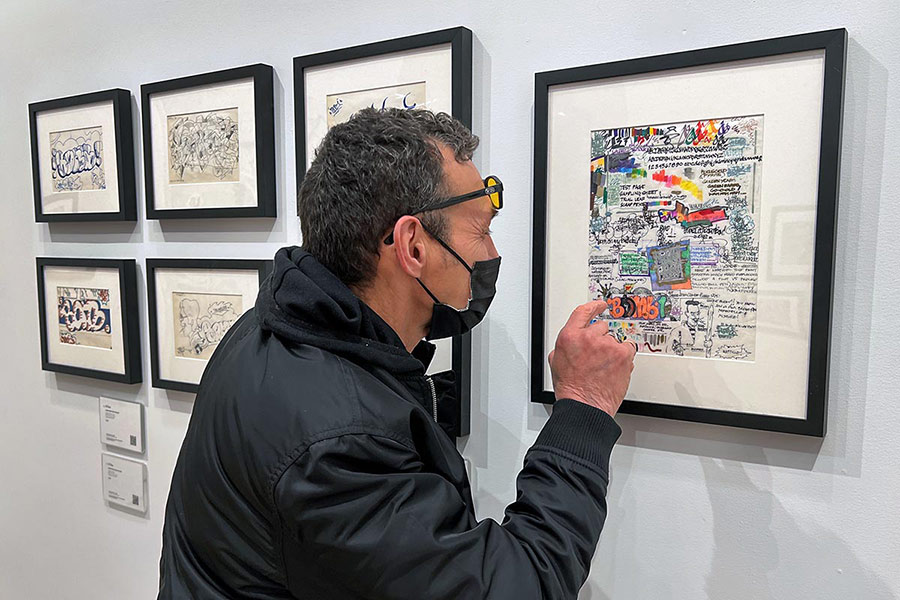
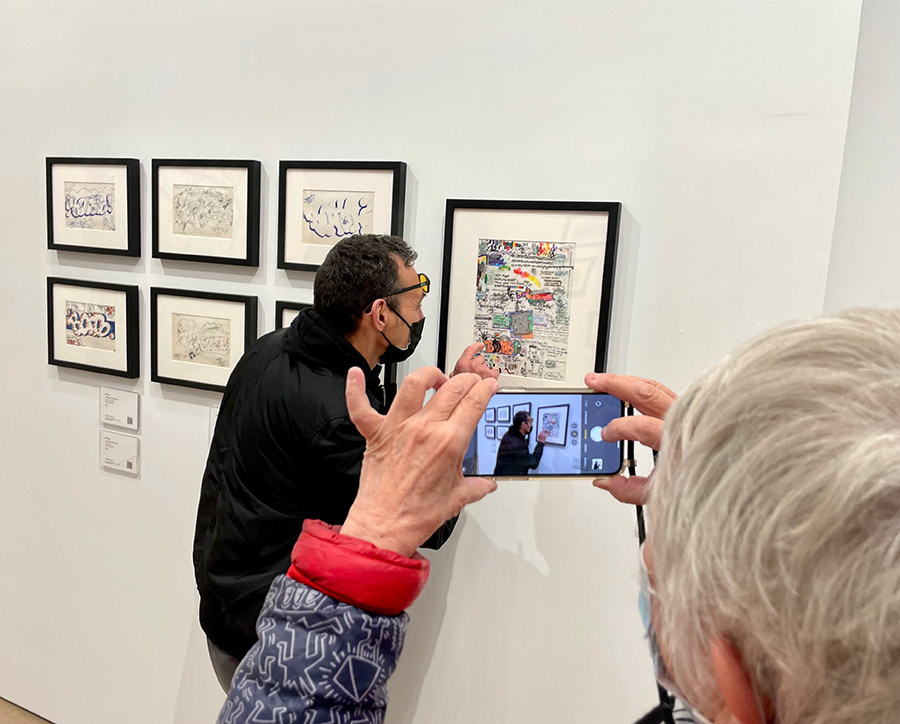
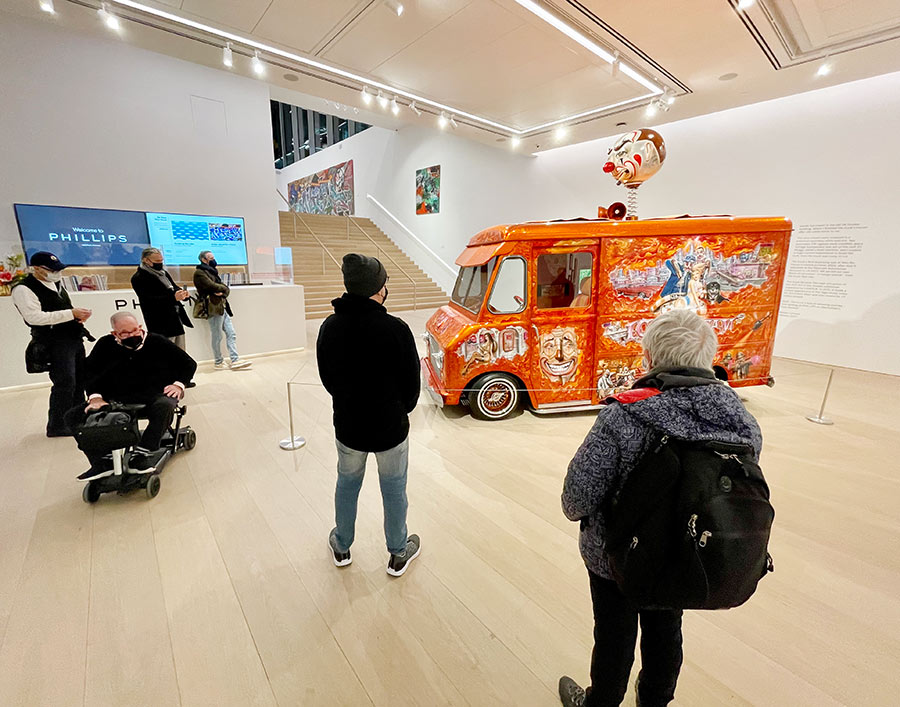
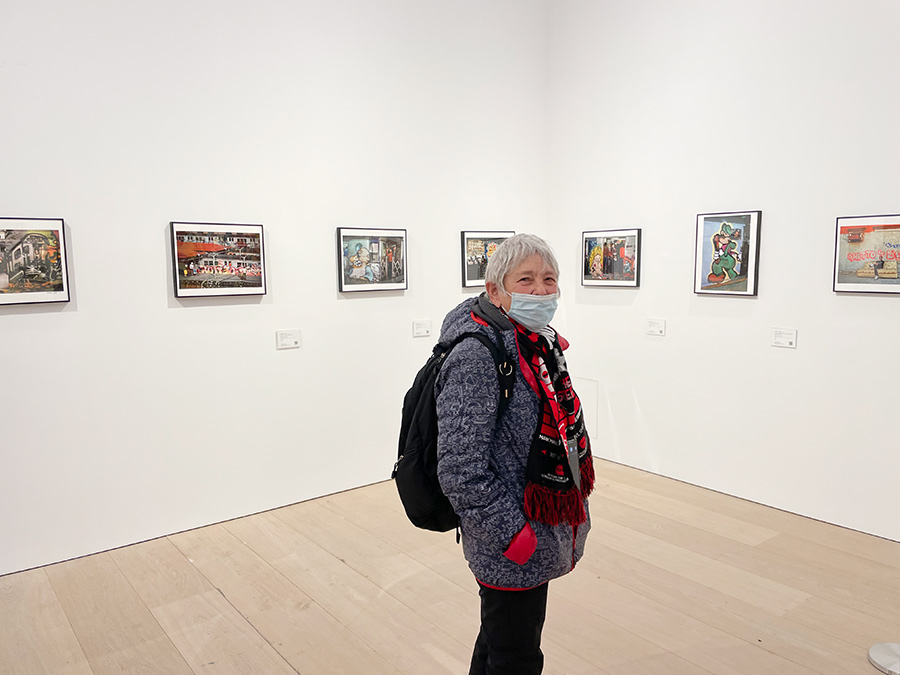
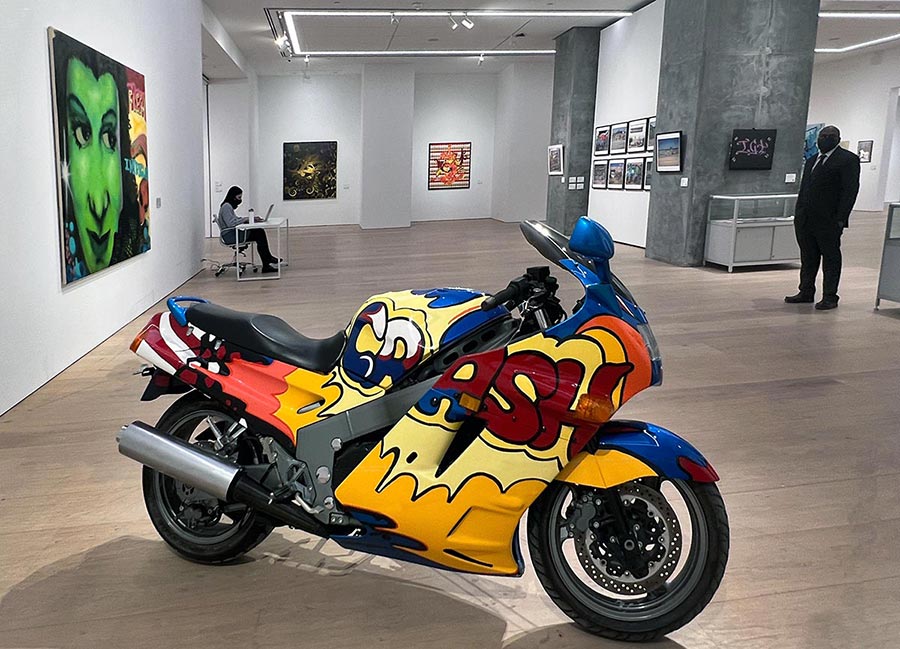
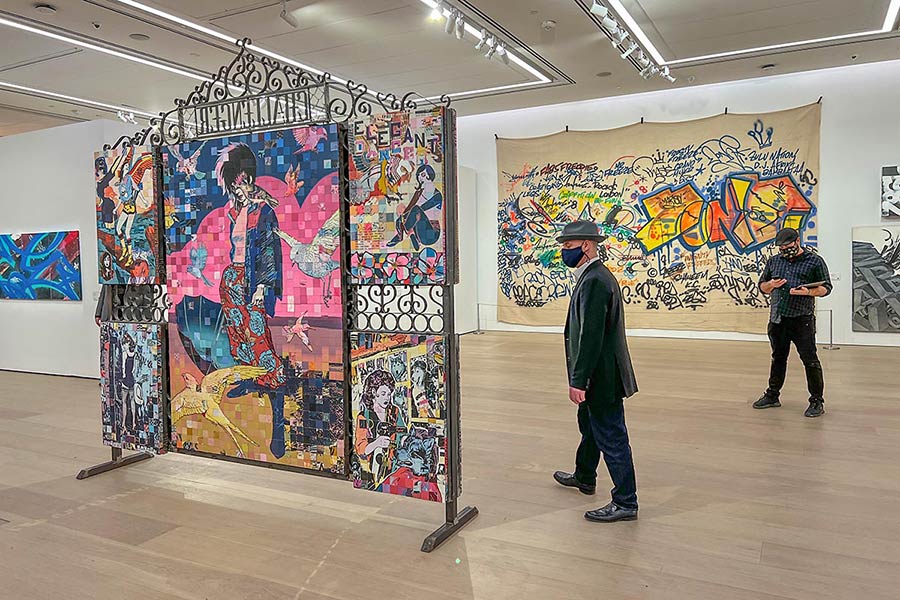
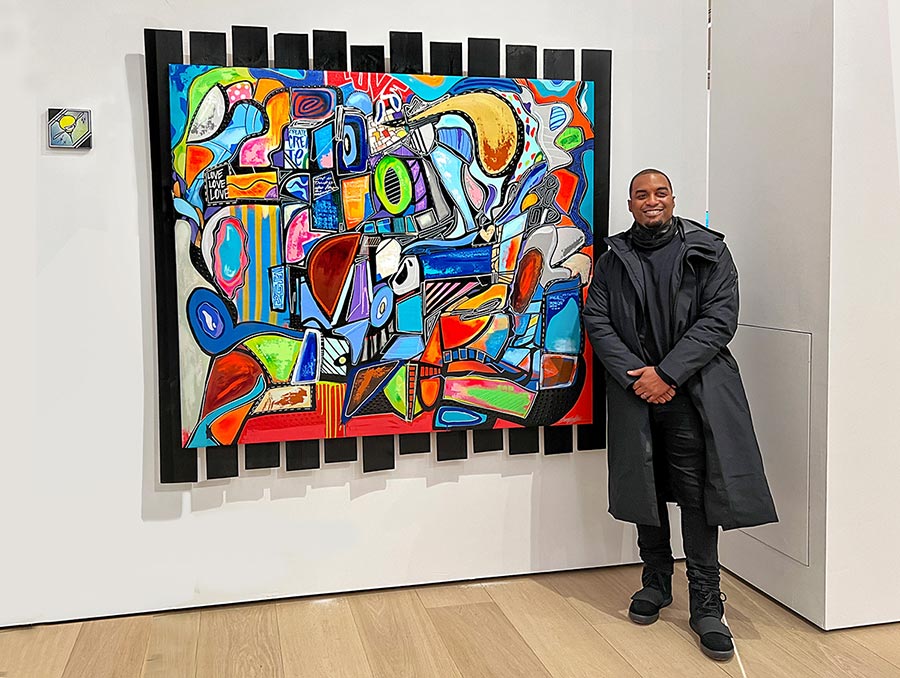
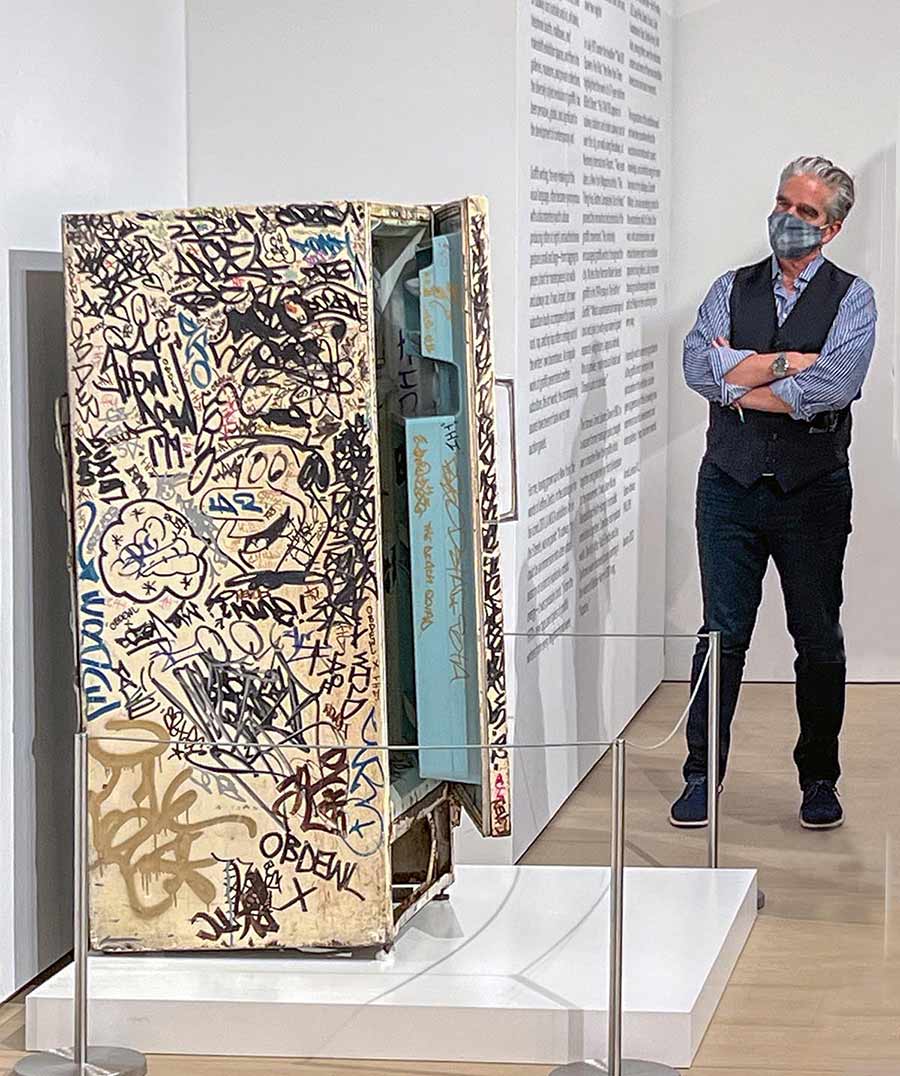
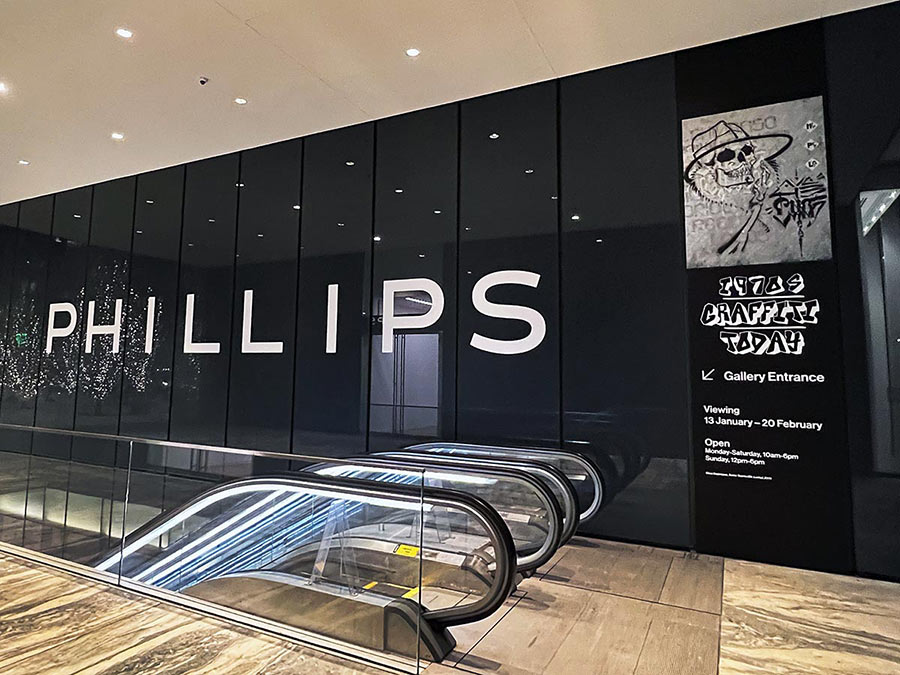
 BROOKLYN STREET ART LOVES YOU MORE EVERY DAY
BROOKLYN STREET ART LOVES YOU MORE EVERY DAY